Devon Trevarrow Flaherty's Blog, page 9
August 20, 2024
Book Review: Dreadful
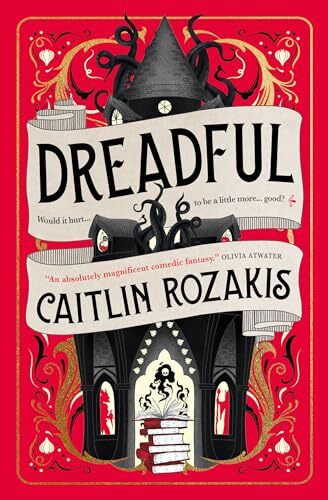
I found Dreadful by Caitlin Rozakis to be a fun, fast, humorous, and charming read. Though charming maybe isn’t quite the word. A fairytale farce novel with the villain-perspective going on and some fun mash-up twists, it still manages to be different from the other villain-y books in its tone and its particular twists. Perhaps it doesn’t flow well betimes; it has a unique voice, plenty of creativity, fairly well-drawn characters, tension in the plot that keeps you guessing, and, well, I might as well mention it here, some evilness and dastardliness that dovetails with the levity to make for some seriously dark humor. There will be death, torture, deception and even demons on the way to our hero’s?—villain’s?—lesson learned?—averted?
Dread Lord Gavrax wakes up one day in the middle of a dark magician’s workshop with his eyebrows missing and half the room on fire. Except he doesn’t know he’s Lord Gavrax because he doesn’t know who he is or what he’s doing in this seriously spooky place. And, honestly, he feels much more like a Gav than a Dread Lord Gavrax. So how did he get here in a castle of goblins and torches with cowering peasants below and a princess locked up above? Nevermind. It doesn’t matter how he got here nearly as much as how he’s going to pull off faking that he knows exactly what’s going on (in front of the servants, the prisoner, the townspeople, the scary magicians who keep ringing in on the magic mirror to check in on the big, devious plan they are working on…) before he gets himself, or everyone around him, killed. Because when you’ve built an evil magician’s life for yourself, you can’t trust anyone. And don’t you actually deserve that?
Ya’ll, this is the first book (and perhaps the only) that I have purchased out of the blue all 2024. I had inventoried my bookshelves over Christmas break and made yet another list of annual TBRs only to join like six book clubs in February and yank in the belt on my TBR even further. The only books I have purchased, therefore, have been for book clubs or other TBR things (like research or reading through the 2023 prize-winners). Every book was decided upon ahead of time. Every book was checked against inventory to make sure that I did not already own it. I carry my spreadsheet in the cloud and therefore in my phone with me to every small bookstore and mall-walk I go on. Therefore, I have bought no “extra” or impromptu books. Not one. Until this.
How did it happen? I was in a Barnes & Noble purchasing a book that was on my list. I can’t recall which one it was, now. It might have even been for a gift. I got to the cash register and was about to pay when I asked if the book I was buying was part of the BOGO half off deal, and the gentleman there gestured to a small stack of books strategically placed between him and I and said, “No, but I can get you half off this book.” I looked confusedly at it for a moment, because it had a BOGO sticker on it, but then I realized that if mine didn’t count, this one shouldn’t count as the half-off one. But Mr. B&N did a few smart things: one, his stack consisted of different titles, so I didn’t feel like he was just hoisting some almost-remainders on me; two, he chatted up the book to me like he had read it and enjoyed it. He appeared to have some reference for what sort of reader I might be. I was impressed. And, I mean, the book had skulls printed on the pages in black and white—you know, like where your thumb sits as you wait to open a book for the first time. Skulls and—could it be?—bulbs of garlic. I wanted to reward this cashier’s courage.
And as soon as I had the smallest amount of breathing space in my TBR, I decided it was the moment to pick up my one rogue title and relax a little. No expectations, for once.
As much as I did enjoy this easy and fantastical read, there is something halting and slowing about the writing style. I wasn’t sure I could say exactly what it was until I entered the quotes below: there are a whole lotta sentence fragments. So that is at least part of it. Also, the writing is repetitive at times and, for my taste, a little too much in Gav’s head. I know that’s where we’re supposed to be and how else could we discover with him who he is and what is going on, but the trend of super-intimate writing is grating on me. Sure, bring me in close to a character, but also tell me a story and take me to a place. Rozakis does this, I just felt a little claustrophobic with Gav.
It’s funny. But be warned: it is very dark humor at times. The story itself and the hook are interesting. The plot lines start weaving together until we have enough questions and tension to carry us through. The fairytale is nontraditional in many ways—not just in characters and plot but also in what we start wanting for people. What I mean is, this is not really a good side of villains thing, but more about change and about actions versus decisions or intentions. And how our past can shape us and how to break the patterns of that. There is some really yucky and horrible stuff in the name of dark humor and the realism of being a Dark Wizard, but everything is painted with a brush of levity. If you think too hard about it, this is adult stuff, but it ends up coming across as appropriate even for children. (Is it though? Probably not.)
Everyone in the reviews seems to talk about toxic masculinity in this book (okay, so it’s even in the book description), but I don’t think they fully understand what’s going on here. It’s really much more a good versus evil thing and a challenging-the-extremes-of-good-and-evil-which-we-normally-see-in-our-stories-and-fairy-tales thing. The main theme is the face that you put on around other people versus who you really are. Action is what counts. And there’s definitely some anger issues to deal with, which I don’t think we have to assume is primarily a male problem just because Gav is male. I was entertained while I thought about some of these things, at least lightly.
It was random that I picked up this book, but I enjoyed it far more than some of the books that have been thrust upon me this year. I liked it more than some similar books, like The Castle Corona, and did think the comparison to Nettle & Bone was apt. It’s a twisted fairy tale of sorts, though the characters are meant to be archetypes instead of specific characters. Rozakis turns the tropes on their heads but in a fresh way that doesn’t let evil off the hook. But we’re still laughing at it. With it. And if you’re not going to be put off by a couple encounters with demons (note: demons stay bad guys—like really bad guys) and some corny portrayal of the entrapments of an evil magician’s life, then you’ll probably enjoy this book. I certainly did. I could even read it again, for fun.

“’You’re not quite what I expected,’ she said at last. / ‘Is anyone?’” (p116).
“But we don’t choose what life we get, we just do our best to make the most of it” (p119).
“’It’s like my ring, isn’t it?’ she said. ‘If people don’t see what they expect to see…’ / ‘They’re disappointed, and then the won’t take you seriously’” (p151).
“’No, of course I care,’ she said. Still stoic. ‘But there’s no point in making a fuss’” (p166).
“’Evil isn’t math, right? It’s not like I can do some magic number of good deeds that will somehow balance out the bad things. I can’t unhurt the people I hurt, even if I tried to change the way I act now” (p189).
“Can’t please anyone. Will never prove to anyone you not evil. They never forgive. Maybe you not deserve then to forgive. Still want to do evil tomorrow? Just because they expect? Even if don’t want to do evil? They choose, not you?” (p190).
“’Who’s the real anyone? When does who you’re pretending to be stop being a pretense and turns into who you really are?’ She shrugged…” (p203).
“Actions mattered. The rest was just excuses” (p322).
“Then, there was nothing fair about birth” (p332).
“’Does it really matter,’ Eliasha asked. ‘What you want? For the rest of the world, all they have to go on is what they see’” (p339).
August 18, 2024
Book Review: Daughter of the Moon Goddess

Here’s the thing: I have an issue with blood. It is a real thing rooted in trauma and it has grown worse with age. Here’s the other thing: Daughter of the Moon Goddess by Sue Lynn Tan very unexpectedly features an awkwardly large number of scenes where the protagonist either bites the inside of her mouth or scratches her hands and ruminates on the taste and/or presence of the blood. I don’t know if this is cultural or just a strange peccadillo for the author, but it is making me queasy just writing about it. It definitely made me ill while reading the book and I kept thinking, Why? Why are we biting our mouth again and commenting on iron?! It’s not like it was a very violent book. Or gory. So, I guess if you are sensitive in the same ways, then you have been warned.
Of course that’s not all I have to say about Daughter of the Moon Goddess. Nor is it the most important thing I have to say about it. I just said it because I meant it. We’re going to move on.
Xingyin grew up isolated on the moon—where her mother was banished as a new immortal, the moon goddess because of the displeasure of the Empress of the Celestial Kingdom. Just as Xingyin begins to discover who she really is and what she’s really doing on the moon she is thrown from her lunar home to navigate a space she has never known, keeping her identity a secret. When she ends up apprenticing beside the Prince she simultaneously puts herself in the most dangerous and more advantageous of situations—a win- or lose-all. But there’s only one thing she wants and she’s willing to do anything to get it, and that’s her mother’s freedom. The key to earning it? Her own magic, her determination, and her friendships—or are they a little more than friendships?
I read this book for the speculative fiction book club I am in. Though it is definitely fantasy (or romantasy), it is also YA, and a number of readers had a hard time with it, I think because they are not regular readers of YA. (Some of the phrases used in book club were “Twilight–y” and “juvenile.”) But these days the lines are blurred and people are going to have to give some space for the other generations and other life stages to read the same books with different expectations and in different ways. (The cumulative review on Goodreads is 4.10, which is impressive.)
I, on the other hand, enjoy fantasy, romance, romantasy, YA, and mythology, so this should have been like my favorite book ever. (Well, maybe that’s taking it a bit far.) And I did enjoy it. But I suppose it was a bit young for me in tone and in themes, like in the way the characters behaved. But sometimes I can understand and appreciate walking a mile in someone else’s shoes. I could do that here, for the most part. And then the writing style and the length of the book came in and… well, I am not entirely sure I want to read the second book in the Celestial Kingdom duology, Heart of the Sun Warrior. I would like it okay, but I would expect it to be too long and in a writing style I don’t fully appreciate.
Here is an example of Tan’s writing style in Moon Goddess:
“An attendant from the Fragrant Coral Palace arrived, bearing a tray of garments for the banquet. Glad for their gracious hospitality, I pulled on the yellow satin dress with turquoise beads thickly sewn into its hem and cuffs. A sea-green sash went around my waist, its silken tassels falling to my knees. The style of this garment was different from those in the Celestial Kingdom, leaving my jade pendant bared below the hollow of my neck. My only other adornment was a comb of pearls tucked into the crown of my head, as my dark hair flowed loosely down my back” (p215).
Yeah. So Tan is big on straight-forward (imperfect) delivery and lots and lots of description of clothes and hair. Though this paragraph is the beginning of a chapter, she wasn’t yet done with these descriptions; there is a second paragraph about the other person’s appearance. It would take a near-encyclopedic knowledge of semi-precious gemstones to even picture half of what all these people are wearing, which I tried to ignore because I thought maybe it’s important for the East Asian readers. But the kinda silly descriptors go even beyond that, like to the excessive use of the words “crimson” and “vermillion” to describe clothing. We know just how everyone’s hair is done in every scene and not because the description was woven into the action. There is so much telling in Tan’s writing, even building up to action scenes—sometimes skipping action altogether just to describe a setting, a meal, or, yes again, an outfit. It was all clear, sure, but I also found the style a bit annoying, not pretty.
And long. This is a long book and I’m not really sure why. I don’t feel like I read that much story (though I could have if she had gone into more depth instead of skipped over many scenes). But I do have many ideas of what food I could serve at a Moon Goddess party or book club dinner.
There is an argument to made for the flat (or 2D) style of the writing and it’s a decent one: this is based on myth or on the Chinese pantheon. So it could sound more like mythology and less like a contemporary novel. Yes. And in some sense that is true of this story at the bare-bones level. But mythology does not consist of half the amount of description that is here. Otherwise, I would have enjoyed the intimacy of the first-person as a teen character, mixed with the unapologetic story arch of mythology. In fact, I did. But that doesn’t excuse most of what’s happening here. And I did enjoy the Chinese gods and goddesses world-building, a whole lot. I thoroughly enjoyed the world Tan created, which—for obvious reasons—felt like some of my favorite wire-fu movies, like Crouching Tiger, Hidden Dragon, but with more unicorns and rainbows (not literally. Literally there were more dragons and riding on clouds).
I also enjoyed that the story went a bit off-script with both the structure and the romance (or love triangle). It really keeps you guessing. Where it didn’t go off-script at all was with Xingyin’s whole “What?! Why is everyone so into me?!” thing. She maintains her plainness and ordinariness all the way through the book while we watch every man and even some women (even the most desirable and attractive in the world) take one glance at her and immediately go gaga. “What?! Why?!” It’s obnoxious. And it’s been used as a device way too often in modern lit. We get it. She doesn’t know just how devastatingly appealing she is. Which means she’s a moron. Come on.
Despite this, there is some good sizzle without having to get explicit or raunchy. This is romantic without being very steamy, which some readers will enjoy. Though some readers find the romance(s) to be disappointing, I didn’t. Not really. Not ultimately. Though I will agree that at least one of the romances was not written out fully and therefore not as exciting or believable. Their time together is inferred, which may have had to do with the mythological tone, but we needed more “just hangin’ out” scenes with love interest number two. I just relaxed and believed Tan for the most part. This is YA. It takes place largely in the head and emotions of the POV character.
My last and most serious complaint: the friends are severely underutilized. Again, because it is YA, we are sitting really close to the protagonist. The book is not about them, it’s about her. But there are only a couple friends in this book (who show up way late) and I spent the first half of the book confused about which one was which. They had no depth, nothing to really carry their memory from scene to scene and, more importantly, they did very little for the story or even for the MC. Theya re certainly underdeveloped.
Which means there are some real flaws with this long-winded foray into Chinese mythology. And yet I enjoyed reading it. I just let things go, let it be. It wasn’t difficult to read. I wanted to know what happened, especially regarding the romance. But I wasn’t exactly riveted either, because I encountered way too many descriptions, way too few character- and plot-deepening scenes, and was often ill from the blood. There are other scenes of violence in this book, by the way, but they are not super graphic or anything. There is a scene where a character attacks another character in attempted assault. FYI. Plenty of readers will enjoy this book, especially if they like fantasy, romantasy, and are into YA. And if they are happy to veer outside the Greek and Norse myths for something different to most books on a Western bookshelf, even better. I think that was my favorite part: stepping into the Celestial Kingdom and Tan’s magical world.

“A palace you cannot escape is a prison nonetheless” (p17).
“’You’ll never grow if you only do what you’re good at,’ she had said. ‘The most difficult things are often the most worthwhile’” (p57).
“You, more than anyone, need to learn how to untether your mind from your feelings. Steady your thoughts and observe, before you plunge ahead. When emotions cloud us, disaster soon follows” (p91).
“But it was so with all knowledge, having just a little left you with a greater thirst” (p177).
“If I had learned anything over these years, it was that no one won in a war, not even those who thought they did” (p287).
“Words held power; they whispered falsehoods into reality, built reputations up or tore them down” (p399).
“The best lies were indeed those steeped in truth” (p414).
“I had been lauded for my bravery, yet I knew the truth—that I had done these things despite my fear. Because not doing them frightened me more” (p482).
“As I gazed across endless night, it dawned on me then, that our paths were forged from the choices we made” (p497).
August 11, 2024
Book Review: Happy Place

I’m going to have to agree with some other readers that Happy Place is not my happy place when it comes to Emily Henry or my vacation reads. But I did enjoy reading it. I still laughed and sighed and felt the sizzle of a romance; this book just had some more issues for me than a couple of her other books, ended up feeling a little flat. I’ll still read Funny Story and then probably whatever else she puts out into the world because so far for me Henry is tops with romance and I enjoy getting lost in her stories now and again.
Harriet and Wyn are the perfect couple. They’ve been together forever and they’ve been engaged for like… I mean… how long has it been again? Every year they spend a week of their summer beachside in Maine with their best friends, but this year is going to be different. For one, they are now three couples and one of them has a big surprise. Two, it’s their last year at the house because it’s being sold soon. And three, well, Harriet and Wyn broke up several months ago and they’ve neglected to tell a single soul. But it’ll be easy to pull off the biggest lie of your life and share a room with your ex for a week straight in your favorite place in the world with all your favorite people, right? You can just fill them in later. Right after you hide all the anger and attraction that just won’t go away.
I keep returning to Emily Henry because I can trust that her romance novels are going to be solid. Enough. And sometimes I need a romance novel, especially when I have been reading some really serious (or sometimes just literary or classic) novels. I tend to reach for something lighter and more genre-driven on vacations, so I followed Normal People with the Emily Henry from last year (the first wrapped up time on Martha’ Vineyard and the other started a trip to Syracuse).
Which means, yes, I am one year behind on her books. I’m just planning to stay that way and then I can snag the year-old paperback from summer to summer. This year, most fans are reading the new Funny Story. I may need to expand my light/genre fiction author options, but I also have Rebecca Yaros and haven’t even begun ACOTAR (or anything Sarah J. Maas). If only Madeline Miller wrote faster… any suggestions? I just want the best writing for very little mental work with maximum addictiveness. Like not always or even most of the time, just when I am in a particular mood/situation.
Oh, you were hoping for a review of Happy Place by Emily Henry? I see. I… might have already said everything when I reviewed her first three adult books, Beach Read, People We Meet on Vacation, and Book Lovers. I enjoy Henry’s books. I am simultaneously impressed by her mastery of the genre, thankful for her readable words, addicted to her characters and plots, and embarrassed by my addiction. (I have read worse. Far worse.) And she makes me laugh now and again. It’s book candy with some depth of feeling and issues and would make either a great Hallmark movie or an even better rom-com blockbuster with two of the hottest actors of the moment. Despite knowing from the beginning what will ultimately happen, Henry’s novels still sizzle and keep me turning the pages.
I don’t think it was my favorite of hers? I dunno. Her books are ranking consistently the same, for me. And there’s something to be said for consistency, but I wouldn’t be mad if I was blown away by just one of them. Maybe Funny Story will be that one.
I do have to agree with some other reviewers, however, that the miscommunication trope in this book is way over the top. Sure, some things happen in the present of the book to distract from proper communication, but what on earth happened six months ago that they couldn’t act like the grown-ups they were and talk to one another? Like even one conversation? I mean, the misunderstanding wasn’t even particularly clear. Why did it blow up like that? There was never a good reason so we were just supposed to be like That’s the way this trope works. Guess I’ll have to buy into a strange-as-butt miscommunication and a comically large and pointless lie. And if you do, you’ll be fine.
Actually, there was one really nit-picky thing that I couldn’t stand but that I haven’t seen a single, other review mention, and that was Harriet’s repeated description of Wyn as having a hard face (like rock, sculpted, whatever) and a soft mouth. She describes it as quicksand more than once. Ew! I wanted to run away from Wyn, definitely not kiss him. This is metaphor gone so wrong, Henry. Please don’t do that to me again. Pretty please.
Small, small note: the relationship was based a little too much on attraction for me, even after all the years the lovers had been together and apart. Bigger note: the relationship lacked commitment or an understanding of love as a commitment, which is related to that small, small note but also to some modern ideas of “love” as transient and, I would say, self-centered.
There is an element of mental health, there, but I don’t think it’s dealt with very deftly.
And the ending did get a little Hallmark-y for me, which had something to do with the main conflict being problematic to begin with… but it went further than that. There were some strange resolutions (read: strange choices), some really cheesy scenes, some timing that made zero sense, coincidental things that were driving the important events (and that is always a big no-no; see my future review of The Marriage Portrait by Maggie O’Farrell). Some peeps called it rushed and it did feel a little bit that way, but I think sloppy is more like it, especially since the set-up of the whole book needed refining, as I’ve already mentioned.
But I had fun reading Happy Place and it’s probable you will too, if that’s the type of thing you read. I still haven’t found someone who does rom-com-y book thing better than Henry and here’s hoping for her next drop to be another winner and only one year away.

“’I’m making them seem terrible,’ I whisper, ‘and they’re not. I don’t know why I get so anxious just being here.’ / His mouth nestles into my temple. ‘I’m here too. I’ve got you’” (p236).
“The only way I can bear loving anyone this much is knowing it will never turn to poison. Knowing we’ll give each other up before we can destroy each other” (p247).
“Every second of every day, I feel like I’m living with a piece of me torn out, and I didn’t even see it happen” (p283).
“Spent like seventeen years operating on fifty-five percent lung capacity without realizing breathing just wasn’t supposed to be that hard. Starting antidepressants was like that for me. I felt like shit all the time, and then suddenly I didn’t. And all this stuff seemed possible for the first time” (p288).
“I’ve tried so hard to be good, to deserve the people around me, and I’ve still managed to hurt all of them” (p310).
“What was school if not a chance to earn your worth? To prove, again and again, that you were measurably good. / One more deal I struck with a disinterested universe: If I’m good enough, I’ll be happy. / I’ll be loved. / I’ll be safe. / Instead, I’ve pushed away everyone I love” (p312).
“’Everyone fights with the people they love, Harriet,’ he says. ‘What matters is how you do it’” (p316).
“’It’s okay to walk away,’ he says. ‘Everyone says Don’t go to bed angry, but sometimes a person needs time to think. And if you need that, it’s okay, but you should tell me, because otherwise…’ His jaw flexes on a swallow. ‘Otherwise, the person might assume you’re leaving for good’” (p316).
“’More Hank wisdom,’ he says. ‘Love means constantly saying you’re sorry, and then doing better’” (p323).

Not a movie yet, but they are supposed to be working on one for this book (or all the books). (As of 2023 into 2024, it’s like a space race to see who will land a Henry movie on the moon first. J-Lo is involved. People We Meet on Vacation might be the furthest along. And there are no guarantees we’ll see even one.) There are theories that rom-coms don’t pull in silver screen viewers these days, but my husband and I will definitely be there when a Henry movie hits the big screen.
August 6, 2024
Literary Eats: Harry’s Birthday Cake
It was the eve of my birthday and I was headed to a book club meeting, except we were meeting at one of the leader’s houses and we were going to watch a (book-related) movie—an annual event. We were told we could bring treats; I took that as an opportunity to do some cooking or baking to impress my new friends. But it was the eve of my birthday… so what better way to celebrate at a book club than a literary birthday cake? Maybe it will become an annual tradition.
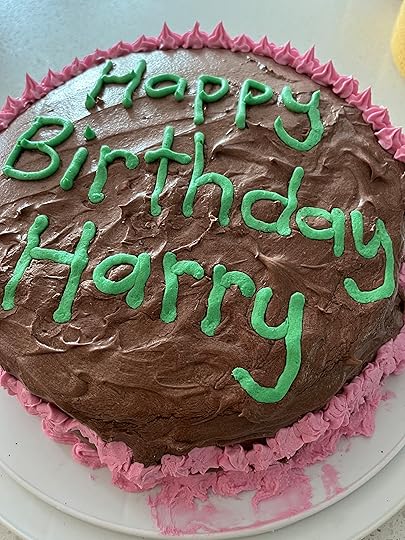
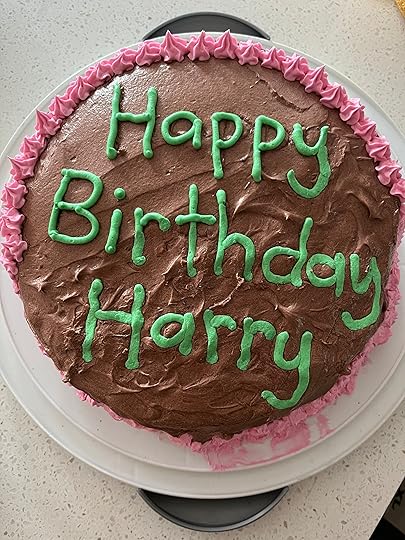
I would have included the box had I thought of the idea early enough.
“Anyway—Harry,” said the giant, turning his back on the Dursleys, “a very happy birthday to yeh. Got summat fer yeh here—I mighta sat on it at some point, but it’ll taste all right.”
From an inside pocket of his black overcoat he pulled a slightly squashed box. Harry opened it with trembling fingers. Inside was a large, sticky chocolate cake with Happy Birthday Harry written on it in green icing.
Harry Potter and the Sorcerer’s Stone, J. K. Rowling

Note: You’ll need green and pink food coloring, a small round and medium star piping tip with piping bags, a cake box and a round cake board that will fit into the box.
Another note: I decided to stick with the book version of Harry’s cake as opposed to the movie version, since this is a literary birthday cake. The book version is chocolate (not pink-frosted) and the writing on top is not misspelled, which is a bit of an insult to Hagrid anyhow. I added pink decorator flourishes because the book doesn’t go into great detail–a little bit in homage to Hagrid’s pink umbrella and his soft side.
Preheat oven to 350F. Grease and flour parchment paper into the bottom of two round cake pans. Set aside.In a mixing bowl or mixer, mix together 1 1/3 cups brown sugar and 1/3 cup plus 1 T neutral oil. Add 2 eggs and mix again. Add 1 cup sour cream and mix again.Sift 2 cups ap flour and ¾ cups plus 2 T cocoa powder over the wet mixture. Sprinkle with 1 t baking powder, 2 t baking soda, and ¾ t salt. Mix just until combined.Slowly add 1 cup hot, strong coffee, mixing just until it is incorporated.Divide the batter evenly between the two pans.Bake for 30-45 minutes until a toothpick comes out clean. Set aside to cool for 5-20 minutes before turning out on a cooling rack to cool completely.Meanwhile, let 1 cup milk and 2 cups unsalted butter come to room temperature.Cream 1 ½ cups of the butter until light and fluffy.Sift in 1 cup cocoa powder and ½ t salt and mix into butter.Sift in 5 cups powdered sugar, stopping between each cup to add enough of the milk to bring it to frosting consistency.Add 1 t vanilla extract and 1-2 sleeves of espresso powder. Taste frosting for flavor and keep adjusting with powdered sugar and milk until frosting is the consistency you wanted. If it seizes, either keep whipping or add mild heat and keep whipping until it pulls back together. (Some of your ingredients may have been too cold.) Set aside, covered.Meanwhile, cream remaining ½ cup of the butter (or ¼ cup butter and ¼ cup vegetable shortening) until light and fluffy. Sift in 2-2 ½ cups powdered sugar and ¼ t salt.Add in 1 t vanilla extract and milk by the tablespoon until it is a smooth, stiff consistency.Divide frosting into a smaller portion and a larger portion, about 1/3rd and 2/3rds. Color the larger portion pink and the smaller portion green. Then put the green frosting in a small, round-tipped piping bag and the pink in a medium, star-tipped piping bag. Set aside.Meanwhile, rough up a cake box enough that it looks “slightly squashed,” especially on the half where it will be opened from. Set aside.When cakes are cooled, dab a small bit of frosting in the center of a round cake board. Trim your first cake so that it is flat on the top and place on the round. Generously frost with the chocolate frosting to cover.Trim your second cake so that it is flatter on one end, beginning in the center. This should not be perfect. It is supposed to look squashed. Place on top of the first cake and frost the whole thing, making sure to keep the squashy slant. The flat portion of the cake should have smooth, neat frosting and clean edges while the bottom part should be bumpy and look like it’s sliding off a little.With the green frosting, write “Happy Birthday Harry” on the cake so that it is a little closer to the edges of the bottom part.With the pink frosting, do a decorator border of choice around the top edge of the cake. Make sure it falls off the side of the cake where it is “squashed.”If your cake board is the size of your cake, then place the cake board with cake in the box (securing with a dab of frosting) before doing the next part. If your cake board is wider than your cake, you can do this step before placing in the box. Anyhow, do another decorator border around the bottom of the cake with the pink frosting.Let the frosting set for a couple hours, at least.When the frosting is a little stiff and no longer tacky, use your fingertips to press down on the lettering where the cake is “squashed.” Do the same thing with the edging, just where it is supposed to be “squashed.” Do it again; go ahead, sell it.Maybe throw some twine around the box and serve, preferably from a giant, dark overcoat filled with pockets bursting with strange and magical things.August 5, 2024
Book Review: One of Us Is Lying
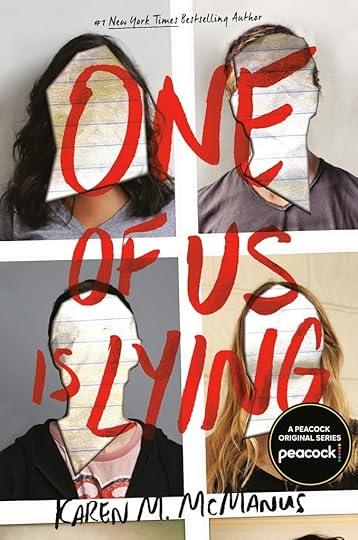
I enjoyed reading One of Us Is Lying by Karen M. McManus, as did most of the other people who read it. It’s a little fluffy, but it’s meant to be: a fun, YA thriller that uses both tropes and cliches to go a little deeper, blending inspiration from The Breakfast Club with modern situations and sensibilities. There are some more serious themes here, including depression, suicide, and being outed for one’s sexuality, but ultimately it’s a thriller in the old whodunnit vein written clearly for teens. It’s good enough, though, for all sorts of people to enjoy it and McManus has launched a large career on the back of this bestselling, award-winning book which has been made into a TV series.
In a modern, crime-centered take on The Breakfast Club, five unlikely-together highschoolers end up in detention where one of them dies. Was it an accident? Was it murder? If it’s murder, then the four other kids in detention—the ones who Simon was about to post enormous, juicy secrets about the next day—are the major suspects. Each of their lives is turned upside down as they become strangers to their town and get to know each other better. Turns out, everyone has secrets; just who would go as far as murder to keep them?
I have been meaning to read this for a while. It is mentioned repeatedly in Save the Cat Writes a YA Novel and my daughter has had it on her shelf for a few years. She likes mysteries and thrillers and YA. I am writing YA and devour YA books when I have the chance. I joined a YA book club for this reason, and the read for June was One of Us Is Lying. Yay! I dove in happily, expecting an easy, addicting little whodunnit, wondering how dark it would get.
I don’t think we have to go super-deep for this read. It is genre fiction that takes tropes and embraces them, cliches and messes with them (at least a little bit) and has a fun time all the while. Most people will also have a fun time reading this book, “That is, unless you don’t like gossipy cat fights and brooding bad boys in love with nerdy girls” (review from Matthew on Goodreads). You will have to encounter death, obviously, as well as depression, suicide, infidelity, and a character being outed against their will. Still, none of this is super deep. It’s more of a wading through the realities on the way through a quick whodunnit.
There are some gimmicks, too. The book is written from five characters’ perspectives, each switch labelled with their name. It is also in present tense, a POV that is growing in popularity despite its awkwardness. I don’t like present tense unless there is a very specific reason. It is pulled off here, but I would rather have had McManus just use good ol’ past tense. Because why not? It reads easier. It’s okay, most readers will enjoy both these things, especially if they are actually teenagers. I love a cast of perspectives, but this one did come off a little hokey. Also note that we are really intimate with the characters, right inside their heads, which is a very-YA thing, as well. Some readers don’t prefer this claustrophobic perspective, but it is also growing as YA readers have been growing up used to it.
Speaking of which, we really drill into the stereotypes here as part of the kitsch, part of the referential nature of this book. Does McManus end up challenging or deepening the stereotypes/cliches enough by the end—because she does give some depth, back-story, and twists to each of the generic characters? That’s part of the point of the whole story—to begin with cookie-cutter characters (they are literally listed out on the back cover) and then slowly reveal that they each have motive, opportunity, a dark side that is just maybe dark enough to do something drastic… or in the case of one character, a light side that could convince us he didn’t do it. In other words, McManus is playing with cliches and stereotypes and that’s the point. Some readers walk away feeling like she really gave dimension to the characters. A few found the stereotypes never graduated (especially concerning one or two characters). Some people are also offended by this, that, or the other of the trope-y elements, but these elements exist as tropes because they work, because they resonate and often because they come from a (simplified) reality. So I dunno’: maybe don’t blame the author for using time-tested and interesting themes and plots and characters. It’s sure working for her. (This is her debut novel and she has moved on to other best-sellers since 2017).
As for the mystery, I’m not sure the real clues are there for you to solve it early on, but maybe that’s okay. Ultimately the clues are there and they eke forward amidst a jumble of red herrings. Like you might make a guess at the beginning, but your guesses will expand and other guesses will bubble up until you aren’t really sure which way is up. If you do think you have it down right at the beginning (this is, after all, trope-y), then plenty of other mysteries are built into the plot, including each of the characters’ secrets (which doesn’t mean just the ones that Simon was about to post). The (tropey bad boy-nerd girl) romance is also obvious from the start, but that doesn’t keep it from being readable and fun.
In the end, there are real consequences and fairly believable people in an almost-relatable situation all wrapped up in a purposely-referential package (the characters, the plot, the mystery, the romance, the setting, all of it). It is like an updated The Breakfast Club and people—especially YA people—have been eating it up since its publication in 2017. I would recommend it even though the writing is, um, light, as in passable. I think it does what it meant to do; it’s not the best book I’ve ever read or even great literature, but it’s fun and way better than most YA thrillers. So live a little. Let it be entertaining and both nostalgic and modern. Then maybe watch the show.
The One of Us Is Lying universe has expanded to include:
 Image from Amazon.comOne of Us Is LyingOne of Us Is NextOne of Us Is Back
Image from Amazon.comOne of Us Is LyingOne of Us Is NextOne of Us Is BackThe later books are related to the first, so you want to read that first, but you don’t need to keep reading to get the whole story, if you know what I mean. They are a series which you could stop reading at any point (like traditional crime novels, actually).
Her other (standalone) books are
Two Can Keep a SecretThe CousinsYou’ll Be the Death of MeNothing More to TellSuch Charming LiarsThey appear to all be as similar as their covers: MaManus has found her niche—“twisty young adult thrillers”—and it’s a large one.

“The social media alone—it’s like you can’t make a mistake anymore, can you? It follows you everywhere” (p83).
“I don’t know why it’s hard for people to admit that sometimes they’re just assholes who screw up because they don’t expect to get caught. ‘You sound more worried about what people are gonna think,’ I say. / ‘There’s nothing wrong with worrying about what people think. It keeps you off probation’” (p121).

There is a TV series that premiered on Peacock in 2021 and ran for two seasons before it was cancelled. (I think it went off-script to make it a longer-running TV show?) There are a total of 16 episodes and I’ll watch it soon so I can get back to you about it. It appears it was under-watched but that critics really liked it.
August 4, 2024
What to Read in August
The summer will be coming to an end this month (in some ways. The weather won’t get there, but for most of us schedules and activities will cease to be summery before September). Which means it is plausible that you real readers still have a stack of “summer reading” on an end table or bookshelf somewhere. Meaning that you haven’t quite finished all those books you lined up for beaches and car rides and airports. Which means that I don’t need to go overboard with the recommendations this month. (Maybe I am just looking for an excuse to write a short entry this month as I am also catching up on some summer things that got submerged under an avalanche of busy.)

The major holidays in August are my birthday. And lots of other birthdays. So what do I even send your way as far as recommended reading? I have already given you summer reading recommendations, so I think in honor of myself I will just give you a few of my favorite books, but concentrating on books you haven’t thought of in a while or that I don’t get to talk about as much on the blog. Because it’s my birthday.
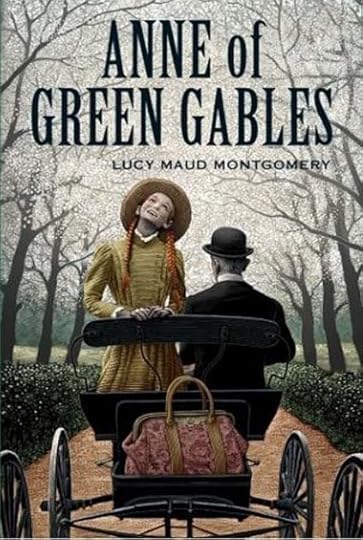
Anne of Green Gables, L. M. Montgomery. I re-read two series every year or two, and one of them is the complete series following Anne of Green Gables. I am also working on an adaptation. And thinking of becoming a Montgomery scholar. I often want to apologize for all this, when it seems like I am hopelessly backward for loving something old-fashioned and out-of-touch. But I am often surprised by just how legion the fans of Anne are… and where I find them.
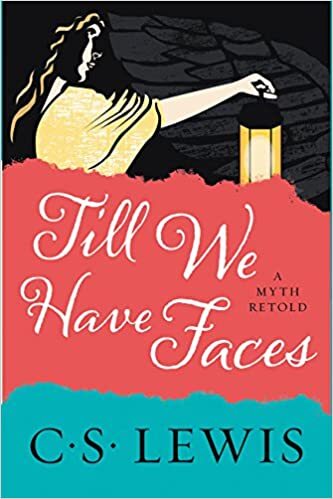
Till We Have Faces, C. S. Lewis. Just when you thought you had a grasp on the many genres of Lewis, here comes this book: a re-telling of the Cupid and Psyche myth for adults. I have re-read this book several times. It is short. It is surprising. And I adore it.
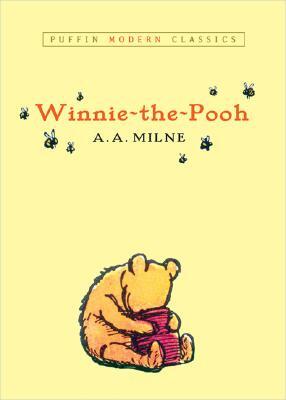
Winnie-the-Pooh, A. A. Milne. So maybe you have thought about Pooh recently, but have you thought about reading the books? You don’t have to be a kid. They are funny and calming and, well, just great writing. And you could follow it up with The House at Pooh Corner and Now We Are Six. It’s especially a great read if you need a mental break or if you are not feeling well.
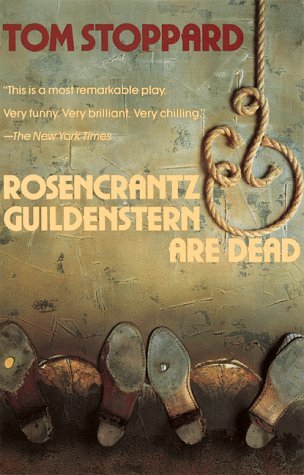
Rosencrantz and Guildenstern Are Dead, Tom Stoppard. I am actually a Tom Stoppard fan and a Shakespeare fan, and this play (and a great movie made from it by Stoppard himself) that spins off from Shakespeare characters in Hamlet is an excellent foray into both worlds. If you like to read plays, then this is the very top of my list. (You will need some knowledge of Hamlet to fully appreciate it.)
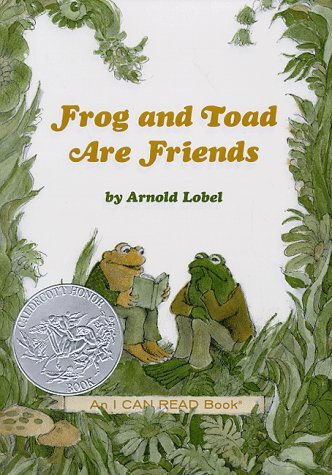
Frog and Toad Are Friends, Arnold Lobel. Lobel is one of my most-reviewed authors on The Starving Artist, because I love his simple, calm, old-world style. His wife, as well, was a talented artist who wrote a memoir I love about her experiences during the Holocaust, No Pretty Pictures. Are Frog and Toad gay? They are certainly gay icons. It turns out, or so they say, Lobel was gay and lived a double-life as a gay man and a husband and father with his life partner, Anita. There are probably gay themes to explore in Frog and Toad if you want to, but the thing is, Frog and Toad are not literally gay, as in they are not presented that way (for multiple reasons, including that there was no way that would have been published then). They are friends and I am so happy to be in a space with two same-sex friends who care for one another and enjoy one another. I seek out books that portray loving and deep friendships and I’m happy to sit there with Frog and Toad any day.
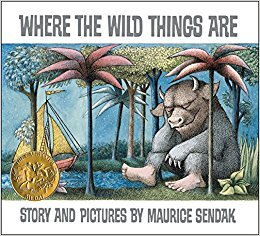
Where the Wild Things Are, Maurice Sendak. Sure, Sendak is a genius with illustration, but it wasn’t until I was an adult that I really appreciated Where the Wild Things Are. Now, I give it as a gift at every baby shower I go to. Why? Because I wish for every child that they have a home they can return to, no matter what sort of wild rumpus they get up to in this very big world.
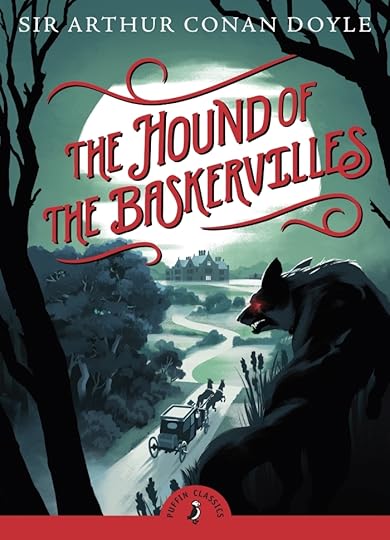
The Hound of the Baskervilles, Sir Arthur Conan Doyle. I am also a Sherlock Holmes fan and this is my favorite of his stories/books. It’s short. It’s a great read if you are winding up for Halloween or if you like gothic fiction or classic detective tales.
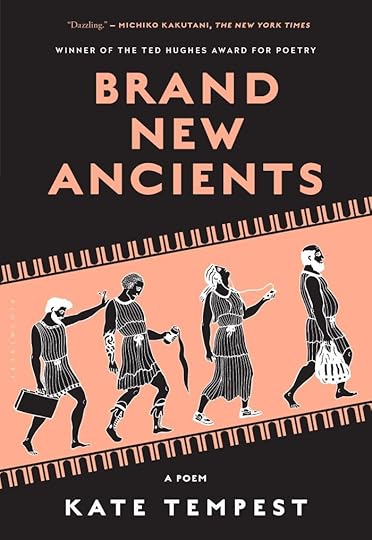
Brand New Ancients, Kae Tempest. Not that many of us still read poetry once we leave school. Sadly. It hasn’t always been this way. But when I read my way through a list of favorite poems I was blown away by this modern, novella-length poem. The best way to enjoy it is read aloud by the artist since it’s meant to be performed, but I also loved reading it myself.
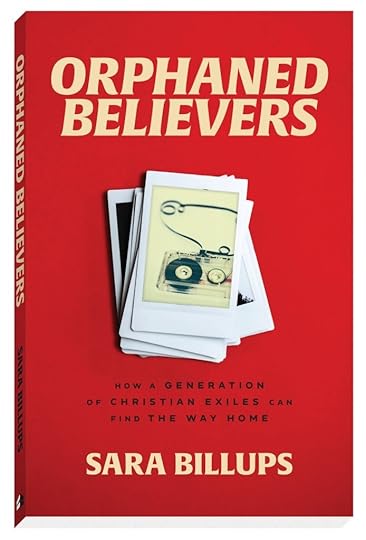
Orphaned Believers, Sara Billups. This isn’t a book for everyone, but it is a book for me and many others. It is part-memoir about a woman and her dying father, it is part history of the evangelical church, and it is part hope and call-to-action to all the masses who feel “orphaned” from the evangelical church. This book was calm in the storm and lighthouse on the shore for me when I was figuring out where to go from some of my disillusionment and disappointment regarding the American Church. We are certainly not alone.
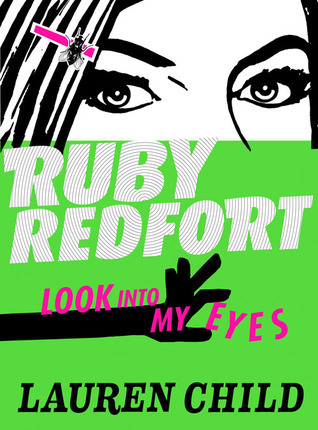
Ruby Redfort series, Lauren Child. I love Lauren Child, which began with reading the Charlie & Lola books aloud to my kids (with an accent, of course). I am head over heels when it comes to her illustration style; (I am a collage artist as well). And I find her writing to be whimsical and down-right fun to read. Ruby Redfort is her series meant for older kids, so I find it a little more relatable, but I also love Clarice Bean, and Lola of course.

How to Train Your Dragon series, Cressida Cowell. If you think you’re all set with just watching How to Train Your Dragon or any of its spin-offs, you are sorely mistaken. The 12-book series has almost nothing to do with the Dragon franchise. Instead, you’ll read the first book and find that you are charmed, tickled, and intrigued. The books are wildly imaginative and in the review, I call both Cowell and her college friend, Lauren Child (!), children who have never quite grown up, like Willy Wonka and/or Roald Dahl.
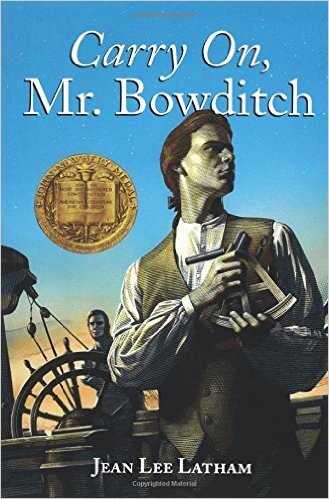
Carry On, Mr. Bowditch, Jean Lee Latham. I might be overdoing how highly I recommend this book, but it was a surprise for me and I utterly enjoyed it. Need some out-loud bedtime reading? Maybe try this one. As for why I have so many children’s books on this list… Not sure. Maybe because reading them will give your mind and emotions a break. Maybe because I have read more overlooked children’s books than adult.


For my birthday, I received one book (at least so far) and that is Coming Home by Brittney Griner. Now, I have revealed before that I like to read the occasional famous-person biography, but I have to have some sort of reason. For this one, I really wanted to know what it was like in a Russian prison camp; it’s not every day that you get to hear what being taking prisoner in Russia really means. There’s Solzhenitsyn’s Gulag Archipelago and the Pulitzer-winning Gulag, but those are about the Soviet Union’s prison camp system in the 20th century. I don’t know how typical Griner’s experience was, but I am willing to read what she went through and hear what she has to say.
As for anticipated publications of the month, we have:


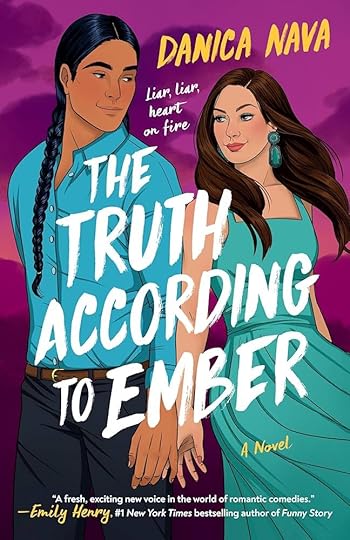
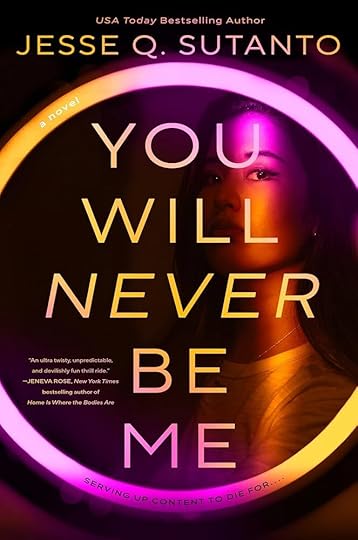 The Housekeeper’s Secret, Iona GreyThere Are Rivers in the Sky, Elif ShafakThe Truth According to Ember, Danica NavaYou Will Never Be Me, Jesse Q. Sutanto
The Housekeeper’s Secret, Iona GreyThere Are Rivers in the Sky, Elif ShafakThe Truth According to Ember, Danica NavaYou Will Never Be Me, Jesse Q. Sutanto

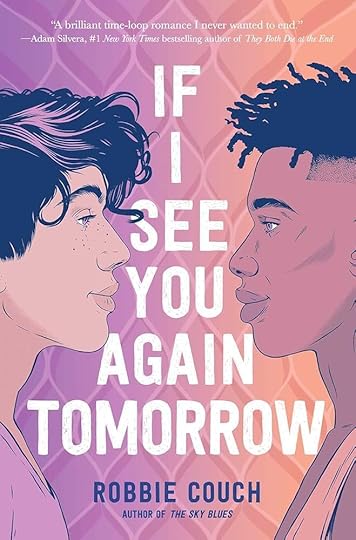



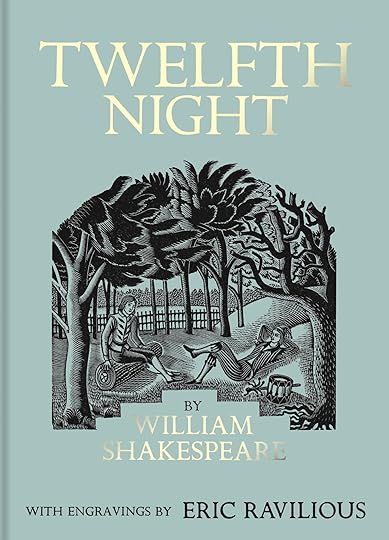

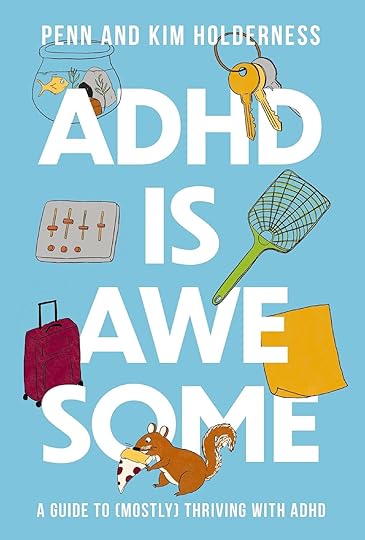 If I See You Again Tomorrow, Robbie Couch (Obviously, I already read it.)Cat’s Cradle, Kurt VonnegutThe Marriage Portrait, Maggie O’FarrellRadiance, Catherynne M. ValenteTwelfth Night, William ShakespeareMartyr!, Kaveh AkbarI am also going to a reading for ADHD Is Awesome by Penn Holderness
If I See You Again Tomorrow, Robbie Couch (Obviously, I already read it.)Cat’s Cradle, Kurt VonnegutThe Marriage Portrait, Maggie O’FarrellRadiance, Catherynne M. ValenteTwelfth Night, William ShakespeareMartyr!, Kaveh AkbarI am also going to a reading for ADHD Is Awesome by Penn Holderness

The best books I’ve read in the past month are:


 Dreadful, Caitlin RozakisIf I See You Again Tomorrow, Robbie CouchI also read the first half of Midnight’s Children by Salman Rushdie before it was pushed back to October (for one of my book clubs). It is excellent but dense and I am looking forward to finishing it in the fall.
Dreadful, Caitlin RozakisIf I See You Again Tomorrow, Robbie CouchI also read the first half of Midnight’s Children by Salman Rushdie before it was pushed back to October (for one of my book clubs). It is excellent but dense and I am looking forward to finishing it in the fall.
July 28, 2024
Book Review: Normal People
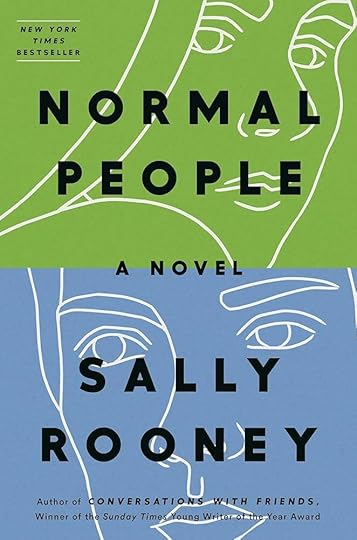
I had so many conflicted feelings when I finished this book. Then I watched the limited streaming series and had more conflicted feelings, but not the same feelings, exactly. And then the New York Times published their best books of the twenty-first century and then the people’s choice, and there was Normal People again, not to mention that my daughter saw me with a copy and was like “That is one of my all-time favorite books!” Here’s my very abbreviated two cents: it’s a realistically swirling tale, told with impressive, clear prose.
A love story told over a number of years, Marianne and Connell cross paths because Connell’s mum works for Marianne’s. In school, they stay far away from each other; well, everyone stays away from the wealthy and strange and aloof Marianne. But there is something about her that Connell can’t resist, and when they become closer, they hide it from the outside world. But Marianne inspires Connell to follow her to Trinity College before they fall apart. A year later, there they are, away from their hometown and together with their relationship in tatters. It’s the second iteration of their friendship, a relationship that will change a few times as Marianne becomes sought-after in college when Connell now feels lonely. Then Marianne deals with childhood trauma by self-destructing while Connell stumbles upon success. No matter what, they can never seem to avoid one another for long, and they wouldn’t want to.
I’m going to be honest; I don’t always know what’s going on in the book world. I don’t know what it is about the book Normal People—it could have been the immediate and repetitive appearance on the summer reads tables at the bookstores since its publication in 2018—but I thought this was an older book. Like the 90s, at the latest. And it actually can read that way. (I had to hit the first obvious reference to modern times to know I wasn’t in the 80s, actually). And with a name like Sally Rooney? Where I come from, this is an older name. Plus, how accomplished she is. And with a 2020 streaming series and all the hype and everything… yeah. I had no idea what I was about to read.
It has been on my radar and my TBR for some time, however. So when I was out of town and looking for a kinda light and easy read for a writing conference bedtime, I grabbed this one. If you are laughing because I said light and easy, then please understand I was in a hurry in the bookstore. Also, I did find the book to go down real easy. And in its way, it is light. Like in its presentation of some very heavy issues and an ultimately serious and emotional relationship. In fact, I found the presentation so light that I didn’t even entertain the idea of crying or gasping; I was a cold fish about all the horrible and sad things. Except maybe when the communication went bad sometimes (and it so often went so, so bad) and during one particular scene with Marianne and a new boyfriend; those couple times I was respectively frustrated and fuming mad.
Let’s just deal with the notes I jotted down after reading it, one at a time:
The portrayal of writers and the writing life is (once again) all wrong. Connell stumbles into writing, has no real stick-to-it-tiveness about it, and then the first person he ever approaches with a work begs him to let her publish it? It goes beyond that, too, but I don’t want to give too much away. Perhaps this is O’Farrell’s life, but I tired of romanticized versions of writing as a career a long time ago.This is Ireland and Irish culture. Don’t forget this is not an American book, people. It might help if every time they say “Jesus,” think “JAY-zuss!”There are some unnecessary choices Rooney made that are very popular as a writing style, especially in Ireland. However, with Rooney at the helm I was not the least bit confused and rarely distracted by the lack of quotation marks, present tense, etc. That is saying something about her skill. But I still don’t know why we are writing without conventional grammar and outside of usual writing style. Is it some sort of rebellion thing? Protesting the colonizer? I’m making stuff up.The tense changes. Because the story slips around in time so much: that’s why it’s done. I think. A reader can use these changes to understand if they are in the “present” of the story or the past, but it can be disorienting and maddening, too. I can see how some people might hate it and how it can feel arbitrary. Perhaps a more obvious way of delineating between present and past? Like headers or something?I definitely agree that all the characters except Marianne, Connell, and Lorraine were so, so flat. I got really confused who people were because I had zero invested in the side characters. Maybe Rachel I remembered, and the nicer friend, Joanna. I really could have used more clarification, more knowing who people were and what they looked like. Peggy really confused me because I had an idea of her from the little I was given and then it kept having to change. I wanted way more of Lorraine. And the story doesn’t really work right (in the end) without more of Alan and Denise.It’s a Millennial novel. So there’s that. Millennials might enjoy it more, relate to its style and ideas more (including political ideas, dysthymia, sexual ideas….).Ultimately, I was taken with the tightness of the writing, the skill of it. But by midway I wasn’t sure I trusted the experience. And by the end I was uncomfortable, and not in a good way. I was really concerned for Marianne’s character, her story arc, the flippancy with which she takes a downward spiral of self-hate and disassociation-to-the-point-of-blankness and shrugs and says well we all submit to someone, right? So why not just take all that hot mess and submit to someone who loves me? What the hell. There is some kernel of wisdom to this conclusion, but Marianne is in no way at the point to learn or to accept this, as a character. Which is, arguably, why Rooney gave us the ending that she did. (The ending is definitely a sore point for many people.) Still, I felt little emotional involvement beside irritation at the situation the characters were in, because character development was lacking in a way that made the story, ultimately, unbelievable. I’m not the only person to feel this way.
And some people absolutely love this book (including Barack Obama and Taylor Swift, I am told). I just landed more in the middle.
Warnings, for sure: abuse, graphic sex, disordered eating, suicide, suicidal ideations, depression… There might be some others, too. There’s some real heavy content in this book even though it doesn’t read that heavy. Still, the content is there.

 Image from the New York Times
Image from the New York TimesSally Rooney is a well-adored, Irish writer, even though she only has three novels. They are, of course, Normal People (her most popular, so far), Conversations with Friends, and Beautiful World, Where Are You. Normal People won a bunch of awards and was short-listed for the Mann Booker Prize. Rooney was named the Young Writer of the Year by The Sunday Times in 2017. In 2022, Time named her one of the 100 Most Influential People in the World. She co-wrote the adaptation for the TV series for Normal People. Interesting factoid: she has an MA from Trinity in American Literature. She wrote Conversations with Friends during her MA program. She is involved in politics, some, as a feminist and Marxist.
There are some interviews and articles to listen to and read at her publisher’s page HERE.
Her next novel, Intermezzo, will be published in September. It contains (centrally) an affair and a relationship between an older man and a young woman, which means I will probably be avoiding it (as I have already read like three of those this year. And, uh-no.) In the pre-pub material, Sally Rooney is called a “global phenomenon.” Which I suppose she is.

“Nothing could be further from his mind than committing mass murder. He feels guilty after he stammers a word on the phone” (p209).
“Not for the first time Marianne thinks cruelty does not only hurt the victim, but the perpetrator also, and maybe more deeply and more permanently” (p232).
“She hates the person she has become, without feeling any power to change anything about herself” (p244).

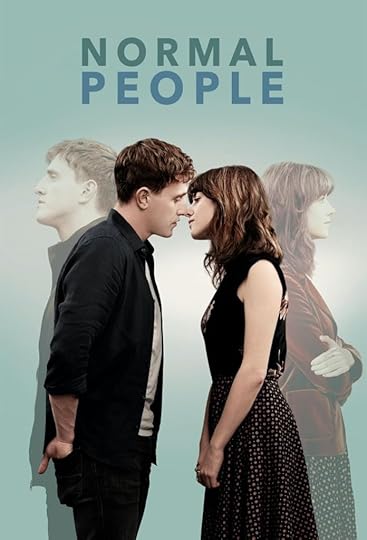
As mentioned, Rooney co-wrote on an (Emmy) award-winning, 12-part limited series for Normal People. I think the story and characters actually do better as the show, but the merit of the piece as a book—the language, the looping plot, etc.—does better as a book. There is an insane amount of explicit sex in both the book and series, and I leave it to you to determine whether or not you can handle those things in either form. (Talking full-on nudity and beginning-to-end sex in the series.) As well as all the other “warnings” that I listed above. But I really appreciated being able to see the settings and get the characters straight (especially with subtitles). Then again, if I had just seen the series I would have balked at it, first for the gratuitous sex and then for its dysthymia, melancholy, slowness. It’s like the two things work in tandem. They did try to catch the lyrical looping by making some episodes begin with the end of the episode and then go back. I liked that though it felt forced after the first couple times—and yet I wouldn’t change it; in fact, I would have done it for every episode. Did they do it for every episode? I didn’t notice until a few in.
July 25, 2024
The Artist Recommends: Trending Best of the Century Book Lists
Sure, there’s a bunch of political stuff going on, but the book news in the past week or two has also been blowing up, unpredictably so. It all began with a little list that the New York Times put out. They put book lists out all the time and why they chose this moment for a retrospective of best books of the 2000s (so far, obviously), I’m not quite sure. But if you are a reader, it’s likely this one crossed your lips and your feeds in the past several days.
 Image from The New York Times, which they seem to be plastering everywhere, so I thought…
Image from The New York Times, which they seem to be plastering everywhere, so I thought…I’m not going to reproduce the lists here for you (because that wouldn’t be right), but we’re going to interact with them a little bit. I’m gonna give you my two cents. And I’m going to stay away from the titles I don’t even recognize. Perhaps those are the ones that you should be paying attention to, though. Go find the original list, the one made using the opinions of authors, and perhaps poke around into the lesser-known of those titles. That could be really interesting. Okay, so maybe I’ll do that soon for you.
After the list was published everyone had something to say about it, and the NYTimes quickly canvassed their readers and came up with a complimentary Readers’ Choice version of the list. We’ll be exploring that one here, too. Both of them. (At this point, The Times has opened both these lists to the public. Who knows what they’ll do in the future.)
Note: the more recent stuff is for sure overrepresented. Which happens. But just a warning: there is stuff from the early 2000s that got forgotten about and many titles from the last year or two (that probably won’t stand the test of time for the next version of this list in 25 years) are rated right at the top.
Let’s start by breaking it down. Here are the titles that I have actually read and agree with:

These books are on the BIG LISTS and I read them and I agree that they are something special.
FROM THE NEW YORK TIMES
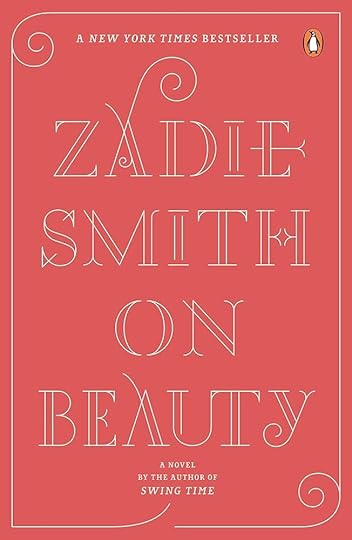
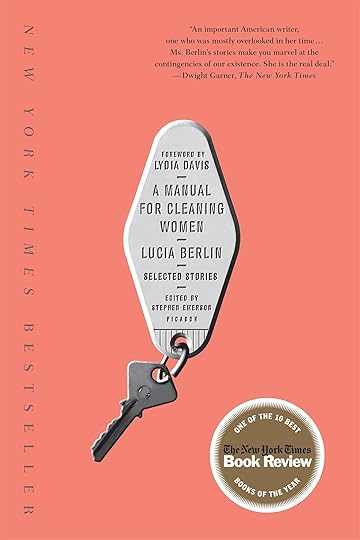


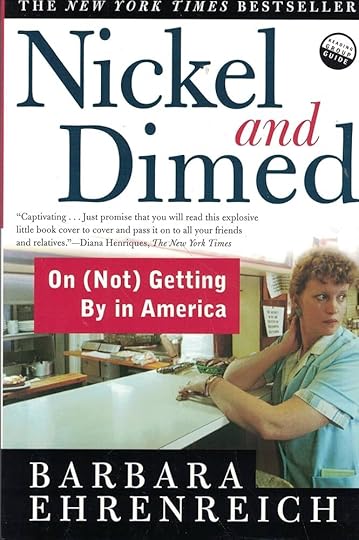
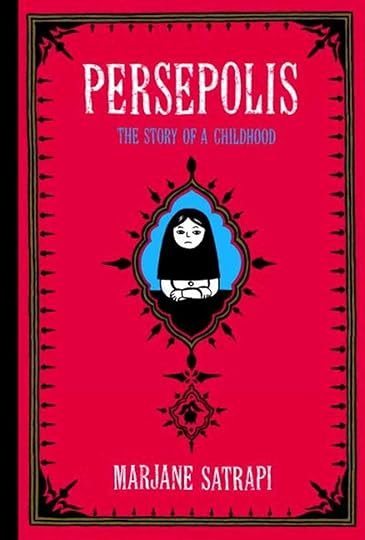
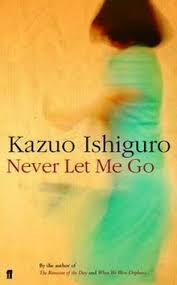
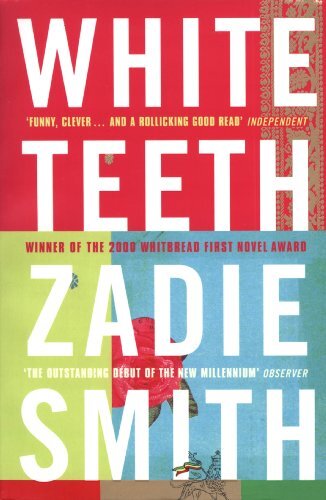
 On Beauty, Zadie Smith (Sorry, haven’t reviewed yet. I am a Zadie Smith fan, though nothing so far tops White Teeth, I don’t think.)
A Manual for Cleaning Women
, Lucia Berlin (Short stories on a best-ofs list? Hurrah.)
Olive Kittridge
, Elizabeth Strout (Um… Would I put it here? Mayyyybe. I did love it.)
The Great Believers
, Rebecca Makkai (Again not sure it’s all the way up there, but a great book.)Nickel and Dimed, Barbara Ehrenreich (Read before I was doing reviews)Persepolis, Marjane Satrapi (Graphic novel. Again, hurrah. I’m sure there are others that deserved this spot, as well. I have not reviewed yet)White Teeth, Zadie Smith
Lincoln in the Bardo
, George Saunders (Emphatically agree.)
Never Let Me Go
, Kazuo Ishiguro (Hmm. I mean, I liked it, for sure.)
On Beauty, Zadie Smith (Sorry, haven’t reviewed yet. I am a Zadie Smith fan, though nothing so far tops White Teeth, I don’t think.)
A Manual for Cleaning Women
, Lucia Berlin (Short stories on a best-ofs list? Hurrah.)
Olive Kittridge
, Elizabeth Strout (Um… Would I put it here? Mayyyybe. I did love it.)
The Great Believers
, Rebecca Makkai (Again not sure it’s all the way up there, but a great book.)Nickel and Dimed, Barbara Ehrenreich (Read before I was doing reviews)Persepolis, Marjane Satrapi (Graphic novel. Again, hurrah. I’m sure there are others that deserved this spot, as well. I have not reviewed yet)White Teeth, Zadie Smith
Lincoln in the Bardo
, George Saunders (Emphatically agree.)
Never Let Me Go
, Kazuo Ishiguro (Hmm. I mean, I liked it, for sure.)FROM THE NEW YORK TIMES READERS’ CHOICE
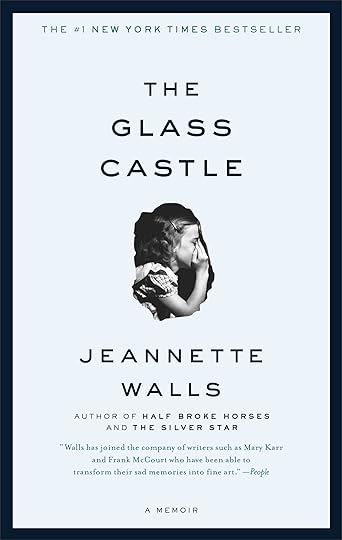
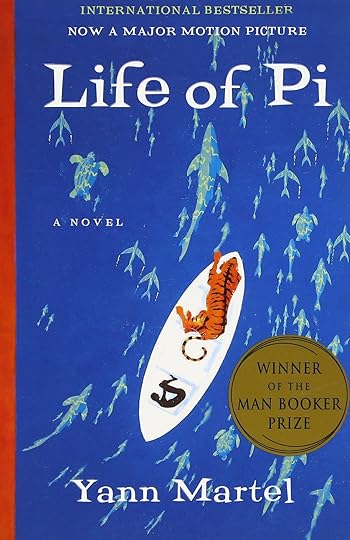
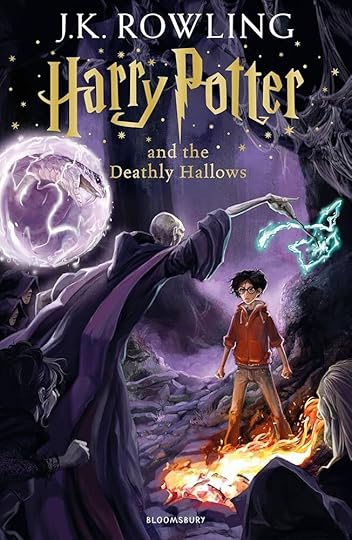
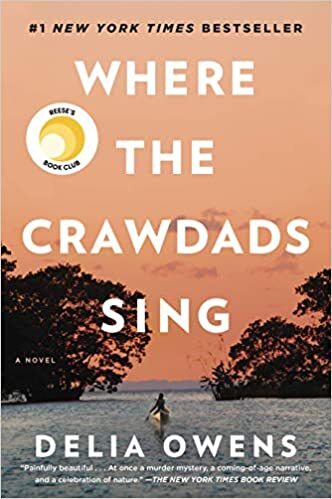



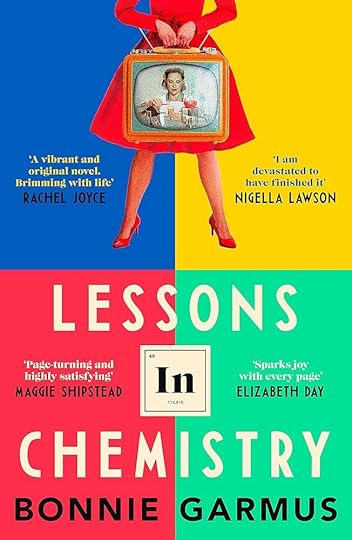





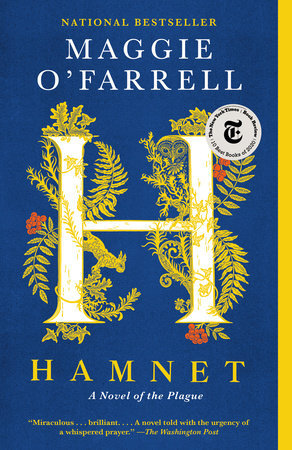


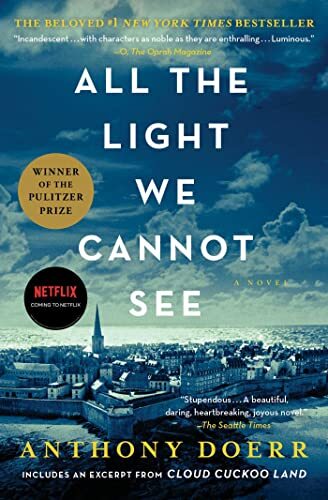 The Glass Castle
, Jeannette Walls (I can see why. Memoir.)Life of Pi, Yann Martel (One from the distant past that got pulled back up.)
Harry Potter and the Deathly Hallows
, J. K. Rowling (The representative to acknowledge Rowling’s contribution to literature. Pretty sure some people are howling about this not-high-art, but for pity’s sake! You can’t get more popular and you can’t get bigger fans. And the woman created a world and told a story that we still haven’t gotten over.)
Where the Crawdads Sing
, Delia Owens (I mean… There is some greatness in it. But is she an accomplice to murder or what?)White Teeth, Zadie SmithThe Hunger Games, Suzanna Collins (This is a great and popular book, genre be darned!)Braiding Sweetgrass, Robin Wall Kimmerer (Surprised me a little, but this dense, hefty, nonfic book is superbly written.)
Gone Girl
, Gillian Flynn (Again, as far as genre goes, this is a good representative of it.)
Lessons in Chemistry
, Bonnie Garmus (Um. I would probably swap this out for something else. But I enjoyed it, for sure.)
The Song of Achilles
, Madeline Miller (Yes. No. I dunno. I do like Miller’s work and it takes her forever. It’s just probably more popular than deserving.)
Olive Kitteridge
, Elizabeth Strout
The Great Believers
, Rebecca Makkai
Circe
, Madeline Miller (See above.)Normal People, Sally Rooney (I am about to review this. I would not have put it here, but I do think it’s a good book. People love their Sally Rooney.)
Hamnet
, Maggie O’Farrell (Yes! Yes! And yes!)
Lincoln in the Bardo
, George Saunders
Never Let Me Go
, Kazuo Ishiguro (Ummm… Maybe. I think he’s a bit overrated.)
All the Light We Cannot See
, Anthony Doerr (Sure. There are some amazing things and some breathtaking writing in this doorstop of a book.)
The Glass Castle
, Jeannette Walls (I can see why. Memoir.)Life of Pi, Yann Martel (One from the distant past that got pulled back up.)
Harry Potter and the Deathly Hallows
, J. K. Rowling (The representative to acknowledge Rowling’s contribution to literature. Pretty sure some people are howling about this not-high-art, but for pity’s sake! You can’t get more popular and you can’t get bigger fans. And the woman created a world and told a story that we still haven’t gotten over.)
Where the Crawdads Sing
, Delia Owens (I mean… There is some greatness in it. But is she an accomplice to murder or what?)White Teeth, Zadie SmithThe Hunger Games, Suzanna Collins (This is a great and popular book, genre be darned!)Braiding Sweetgrass, Robin Wall Kimmerer (Surprised me a little, but this dense, hefty, nonfic book is superbly written.)
Gone Girl
, Gillian Flynn (Again, as far as genre goes, this is a good representative of it.)
Lessons in Chemistry
, Bonnie Garmus (Um. I would probably swap this out for something else. But I enjoyed it, for sure.)
The Song of Achilles
, Madeline Miller (Yes. No. I dunno. I do like Miller’s work and it takes her forever. It’s just probably more popular than deserving.)
Olive Kitteridge
, Elizabeth Strout
The Great Believers
, Rebecca Makkai
Circe
, Madeline Miller (See above.)Normal People, Sally Rooney (I am about to review this. I would not have put it here, but I do think it’s a good book. People love their Sally Rooney.)
Hamnet
, Maggie O’Farrell (Yes! Yes! And yes!)
Lincoln in the Bardo
, George Saunders
Never Let Me Go
, Kazuo Ishiguro (Ummm… Maybe. I think he’s a bit overrated.)
All the Light We Cannot See
, Anthony Doerr (Sure. There are some amazing things and some breathtaking writing in this doorstop of a book.)

Okay, so maybe I did like these books, but I do not agree that they are the best this quarter-century has to offer.
FROM THE NEW YORK TIMES
Stay True, Hua Hsu (A decent book, an interesting read, made a big fuss over even though it had major flaws.) Trust , Hernan Diaz (More experimental than successful, I thought.) The Goldfinch , Donna Tartt (Yeah, no. I don’t get what people insist on seeing in this book.) The Underground Railroad , Colson Whitehead (I found this a disappointing read. Still appreciated it, but find it overrated.)FROM THE NEW YORK TIMES READERS CHOICE
Trust , Hernan DiazThere, There, Tommy Orange (He can write, but so far he hasn’t been about to put together a book I found truly successful.) The Book Thief , Marcus Zusak (Another book I have found overrated. Still, good.) The Underground Railroad , Colson Whitehead The Goldfinch , Donna Tartt
Now I’m going to list all the books from the two lists that are already on my TBR: books that are on my radar and that I intend to read. I haven’t gotten around to so many of the great books of the recent past, it turns out.
FROM THE NEW YORK TIMES
I AM HOMED IN ON THESE ONES:
I might even own them already. I will be reading them… when I have the time.
Station Eleven, Emily St. John MandelThe Sympathizer, Viet Thanh Nguyen (Also so I can watch the show)The Emperor of All Maladies, Siddhartha MukherjeeTomorrow and Tomorrow and Tomorrow, Gabrielle Zevin (Can a person even avoid this book? It doesn’t look like it. Barnes and Noble has a copy right now with teal edging)Demon Copperhead, Barbara Kingsolver (Went from publication to 100 in no time flat)The Fifth Season, N. K. Jemisin (genre!)Cloud Atlas, David Mitchell (I believe this is not an easy read, which makes me hesitate)Salvage the Bones, Jesmyn WardThe Overstory, Richard PowersAmericanah, Chimamanda Ngozi AdichieSing, Unburied, Sing, Jesmyn WardErasure, Percival Everett (I mean, where were these plaudits before the movie? Maybe we just missed out on celebrating a great work till now?)The Amazing Adventures of Kavalier and Clay, Michael ChabonPachinko, Min Jin Lee (Sooo big.)The Road, Cormac McCarthy (Bleak? Did I hear bleak?)The Year of Magical Thinking, Joan DidionThe Brief Wondrous Life of Oscar Wao, Junot DiazWolf Hall, Hilary MantelMy Brilliant Friend, Elena Ferrante (I’m sorry, but where did this one come from? But now that I see it, everybody frickin’ loves it)I’D ALSO REALLY LOVE TO GET TO THESE SOONER THAN LATER:
Bel Canto, Ann Patchett (On the shelf)The Human Stain, Philip RothThe Story of the Lost Child, Elena Ferrante (So curious about Ferrante)An American Marriage, Tayari JonesTenth of December, George Saunders (I lurve George Saunders)A Visit from the Goon Squad, Jennifer Egan (Someone knows how to title a book)Atonement, Ian McEwanHateship, Friendship, Courtship, Loveship, Marriage, Alice MunroBehind the Beautiful Forevers, Katherine BooMiddlesex, Jeffrey Eugenides (On the shelf)The Corrections, Jonathan FranzenThe Known World, Edward P. JonesThe Warmth of Other Suns, Isabel WilkersonAND THESE I HAVE AT LEAST HEARD OF, INTEND TO READ:
Bring Up the Bodies, Hilary MantelFrederick Douglas, David W. BlightPastoralia, George SaundersExit West, Mohsin HamidThe New Jim Crow, Michelle AlexanderFar from the Tree, Andrew SolomonThe Plot Against America, Philip RothRunaway, Alice MunroA Mercy, Toni MorrisonThe Argonauts, Maggie NelsonBetween the World and Me, Ta-Nahesi CoatesThe Last Samurai, Helen DewittEvicted, Matthew DesmondGilead, Marilynn RobinsonAusterlitz, W. G. Sebald2666, Roberto Bolano (So hard to pick this one up if you are superstitious)FROM THE NEW YORK TIMES READERS CHOICE
Notice that the list is longer, meaning I am more of a pedestrian than an author as a reader? Also, so many of these are new, which I don’t love for the list, but it explains why I haven’t read them yet.
Starting over,
I AM HOMED IN ON THESE ONES:
My Year of Rest and Relaxation, Ottessa Moshfegh (Which even my daugther’s read)Tom Lake, Ann Patchett (I am inexplicably so drawn to this one)Deacon King Kong, James McBrideKlara and the Sun, Kazuo IshiguroCrying in H Mart, Michelle Zauner (Even if my daughter didn’t love it)Sing, Unburied, Sing, Jesmyn WardThe Devil in the White City, Erik Larson (I really need to read some Erik Larson)The Sympathizer, Viet Thanh NguyenNorth Woods, Daniel Mason (Will be reading next month for a book club)The Dutch House, Ann PatchettJames, Percival Everett (Kudos to Everett for two appearances here and also on the book-to-movie deal of the century)The Bee Sting, Paul MurrayThe Heaven & Earth Grocery Store, James McBride (I mean, of course)The Brief Wondrous Life of Oscar Wao, Junot DiazThe Kite Runner, Khaled Hosseini (Yeah, I haven’t gotten to it yet)The Year of Magical Thinking, Joan DidionThe Covenant of Water, Abraham VergheseCloud Atlas, David MitchellCloud Cuckoo Land, Anthony Doerr (Another long slogs, I hear)A Visit from the Good Squad, Jennifer EganThe Corrections, Jonathan FranzenHomegoing, Yaa GyasiThe Amazing Adventure of Kavalier and Clay, Michael ChabonAmericanah, Chimamanda Ngozi AdichieMiddlesex, Jeffrey Eugenides (On the shelf)Bel Canto, Ann PatchettThe Road, Corman McCarthyWolf Hall, Hilary Mantel (Haven’t read any Mantel)The Overstory, Richard PowersStation Eleven, Hilary St. John MandelMy Brilliant Friend, Elena FerranteTomorrow and Tomorrow and Tomorrow, Gabrielle ZevinEducated, Tara Westover (My daughter keeps bugging me to read this one)Pachinko, Min Jin LeeDemon Copperhead, Barbara KingsolverI’D ALSO REALLY LOVE TO GET TO THESE SOONER THAN LATER:
A Thousand Splendid Suns, Khaled HousseiniDrive Your Plow Over the Bones of the Dead, Olga TokarczukThe Plot Against America, Phillip Roth (Another author I need to get to)Tenth of December, Geroge SaundersThe Immortal Life of Henrietta Lacks, Rebecca SklootKafka on the Shore, Haruki MurakamiThe Fifth Season, N. K. Jemison11/22/63, Stephen King (Maybe he just needed a represent, but it’s kinda amazing this title is always on the best-ofs)The Nightingale, Kristin HannahBetween the World and Me, Ta-Nehisi CoatesThe Warmth of Other Suns, Isabel WilkersonAtonement, Ian McEwanA Gentleman in Moscow, Amor TowlesThe Nickel Boys, Colson Whitehead (Hoping for more than Underground Railroad from this title)AND THESE I HAVE AT LEAST HEARD OF, INTEND TO READ:
A Man Called Ove, Fredrick BachmanShuggie Bain, Douglas StewartThe Vanishing Half, Brit Bennett1Q84, Haruki MurakamiSapiens, Yuval Noah HarariJust Mercy, Bryan StevensonKillers of the Flower Moon, David Grann (Is it because of the movie?)Piranesi, Susannah ClarkeEvicted, Matthew Desmond2666, Robert BolanoSmall Things Like These, Claire KeeganOn Earth We’re Briefly Gorgeous, Ocean Vuong (I need to read some Vuong)Life After Life, Kate Atkinson (Everywhere on these lists)Gilead, Marilynne Robinson (Everywhere on these lists)Okay, so then I went in search of the supposed Time list that they quickly came up with. I don’t know if it really exists or not, but I couldn’t find it. So, I looked to see if there were any other reactionary lists and found some stuff on Goodreads (which I later figured out could be posted by anyone. I don’t usually use those.) But there were moments on those lists that intrigued me because there were some books I had not heard of (or not super often) that maintained 4+-star ratings over thousands of reviews and I said, “Huh.” Let me list those.
GOODREADS BOOKS THAT SPARKED MY INTEREST:
Against the Day, Thomas PynchonThe Housekeeper and the Professor, Yoko OgawaThe Orphan Master’s Son, Adam JohnsonThe Thing Around Your Neck, Chimamanda Ngosi AdichieThe Shadow of the Wind, Carols Ruiz ZafonThe Moor’s Account, Laila LalamiThe Snow Child, Eowyn IveyBirdsong, Sebastian FaulksOur Souls at Night, Kent HarufA God in Ruins, Kate AtkinsonThe Tsar of Love and Techno, Anthony MarraThe Narrow Road to the Deep North, Richard FlanaganFreedom, Jonathan FranzenCall Me by Your Name, Andre AcimanA Constellation of Vital Phenomena, Anthony MarraThe Namesake, Jhumpa LahiriThe Thousand Autumns of Jacob de Zoet, David MitchellThis I Know, Eldonna EdwardsA Little Life, Hanya YanagiharaOryx and Crake, Margaret AtwoodHalf of a Yellow Sun, Chimamanda Ngozi AdichieThe Curious Incident of a Dog in the Nighttime, Mark HaddonThe Story of a New Name, Elena PerranteA Tale for the Time Being, Ruth OzekiBring Up the Bodies, Hilary MantelAnd finally, this is my list. The list only started when I began reviewing and blogging in something like 2012, but I have read books from across all the centuries of writing. I can’t obviously speak to books I haven’t read yet and I am only one person with some specific proclivities. There are some very specific books and also a couple by people I know, but I am being honest about how much I admire them. (Note: there were a lot of books on my favorites list from the 90s, so they are obviously not here. But their inclusion would have like doubled the list, at least.)


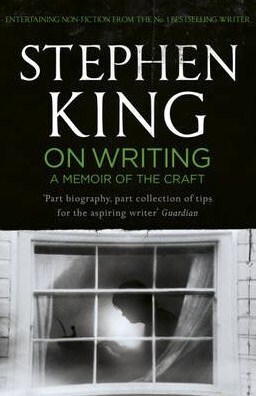


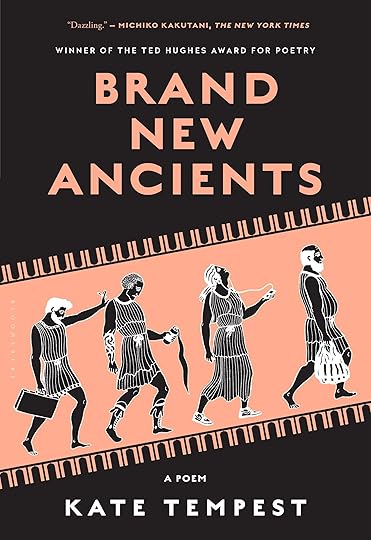

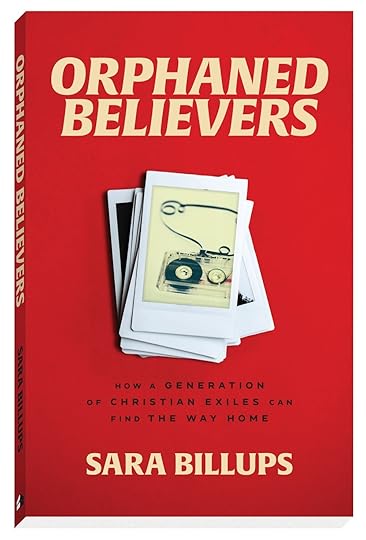

 White Teeth
, Zadie Smith
On Writing
, Stephen KingHarry Potter series, J. K. Rowling
Lincoln in the Bardo
, George SaundersBrand New Ancients, Kae Tempest
After
, Bruce Greyson
Orphaned Believers
, Sara Billups
Prophet Song
, Paul LynchHamnet, Maggie O’Farrell
White Teeth
, Zadie Smith
On Writing
, Stephen KingHarry Potter series, J. K. Rowling
Lincoln in the Bardo
, George SaundersBrand New Ancients, Kae Tempest
After
, Bruce Greyson
Orphaned Believers
, Sara Billups
Prophet Song
, Paul LynchHamnet, Maggie O’Farrell


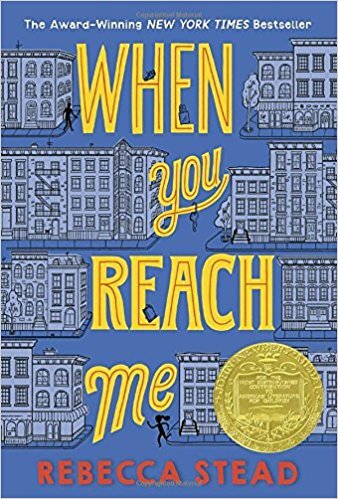
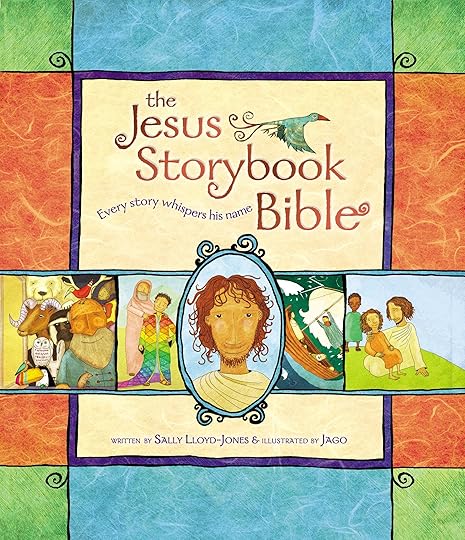
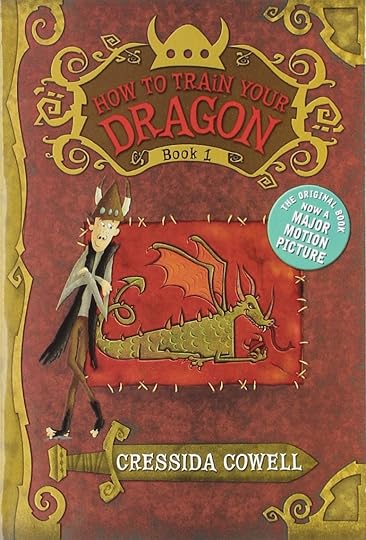
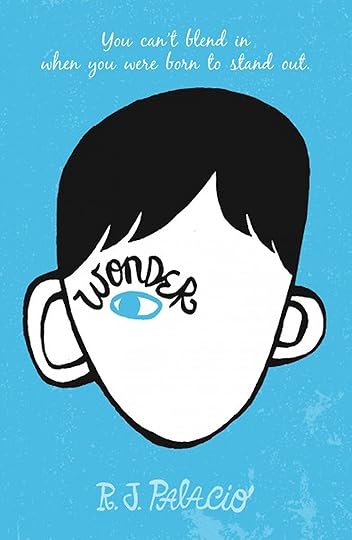
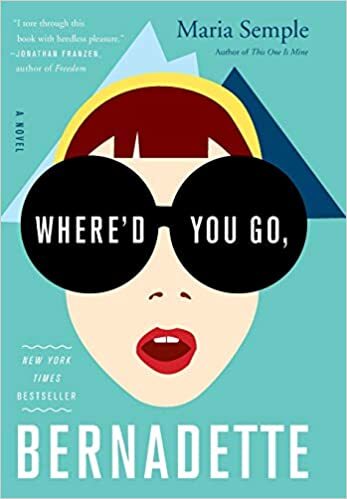
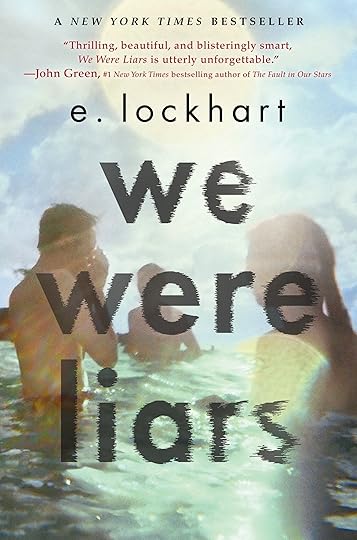
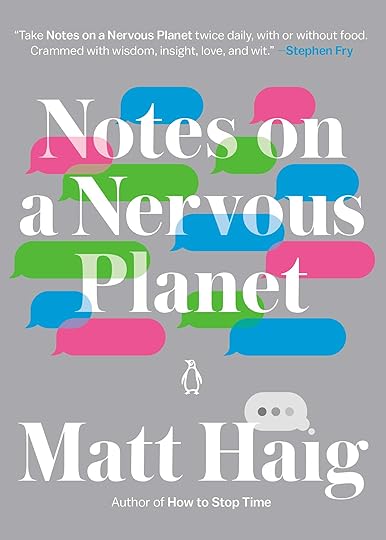
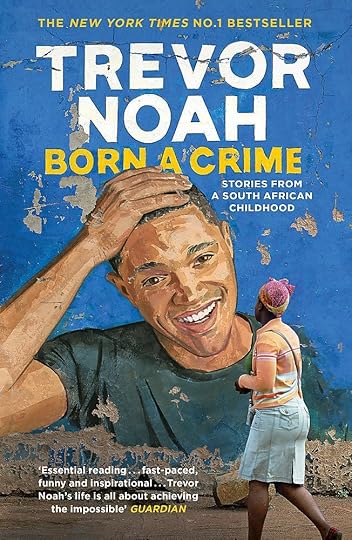


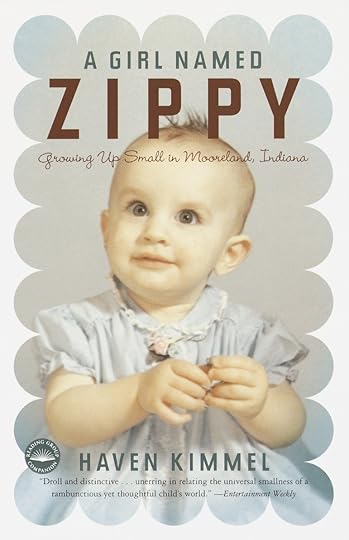
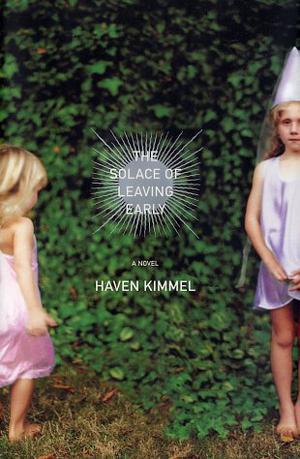
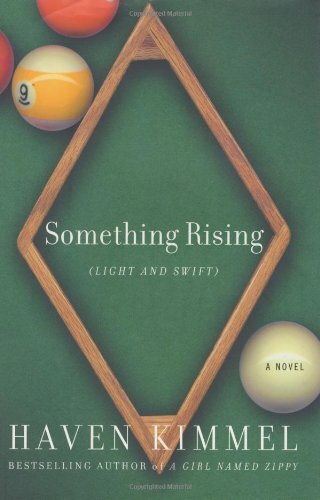
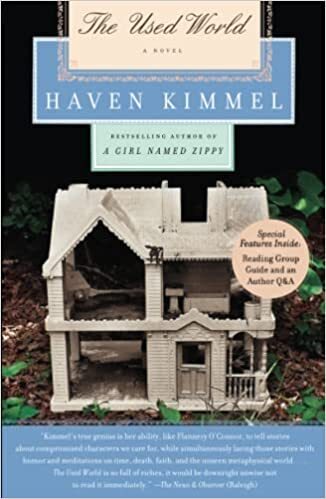
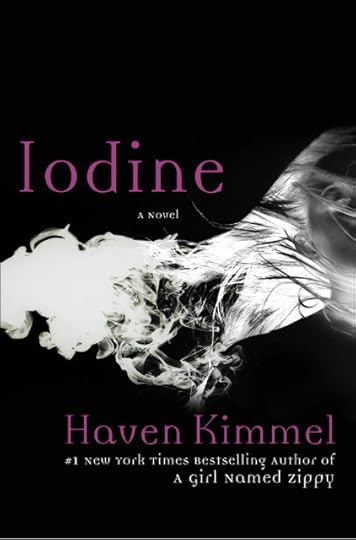
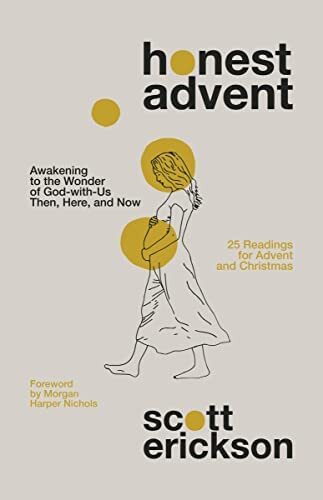




 Ruby Redfort Look Into My Eyes
, Lauren Child
When You Reach Me
, Rebecca Stead
The Jesus Storybook Bible
How to Train Your Dragon series, Cressida Cowell
Wonder
, R. J. PalacioWhere’d You Go, Bernadette?, Maria Semple
We Were Liars
, E. Lockhart
Notes on a Nervous Planet
, Matt HaigBorn a Crime, Trevor Noah
All the Light We Cannot See
, Anthony DoerrSpinning the Vast Fantastic, Britton Shirley Haven KimmelThe Solace of Leaving Early, Something Rising (Light and Swift), and
The Used World
, Haven Kimmel
Iodine
, Haven Kimmel
Honest Advent
, Scott Erickson
Six of Crows
, Leight Bardugo
The Guernsey Literary and Potato Peel Pie Society
, Mary Ann Schaffer and Annie Barrows
The Great Believers
, Rebecca Makkai
Stay with Me
, Ayobami Adebayo
Universal Love
, Alexander Weinstein“Parts Unknown: Narnia,” Rachel Manija Brown (That would be a short story)
Ruby Redfort Look Into My Eyes
, Lauren Child
When You Reach Me
, Rebecca Stead
The Jesus Storybook Bible
How to Train Your Dragon series, Cressida Cowell
Wonder
, R. J. PalacioWhere’d You Go, Bernadette?, Maria Semple
We Were Liars
, E. Lockhart
Notes on a Nervous Planet
, Matt HaigBorn a Crime, Trevor Noah
All the Light We Cannot See
, Anthony DoerrSpinning the Vast Fantastic, Britton Shirley Haven KimmelThe Solace of Leaving Early, Something Rising (Light and Swift), and
The Used World
, Haven Kimmel
Iodine
, Haven Kimmel
Honest Advent
, Scott Erickson
Six of Crows
, Leight Bardugo
The Guernsey Literary and Potato Peel Pie Society
, Mary Ann Schaffer and Annie Barrows
The Great Believers
, Rebecca Makkai
Stay with Me
, Ayobami Adebayo
Universal Love
, Alexander Weinstein“Parts Unknown: Narnia,” Rachel Manija Brown (That would be a short story)Note to self: Do not publish a book in the eleventh hour of a century. It will not qualify for the new century’s lists. Also, do publish books near the end of decades because then people will remember them when they make their best-ofs-whatever-decade lists. Perhaps that holds true for the centuries, too. People still look up best books of the twentieth century, right? I do.
Also, where are Benevolent and The Night of One Hundred Thieves on these lists?! Haha. Just kidding. I’m not quite there yet.

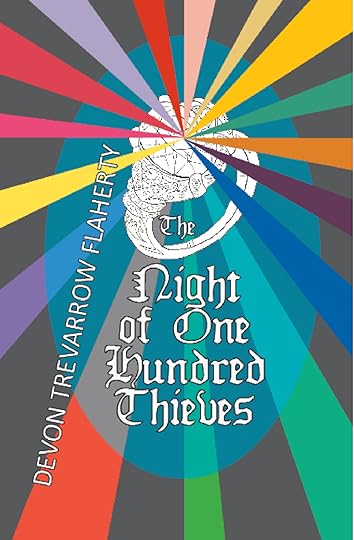
July 23, 2024
Book Review: Nettle & Bone
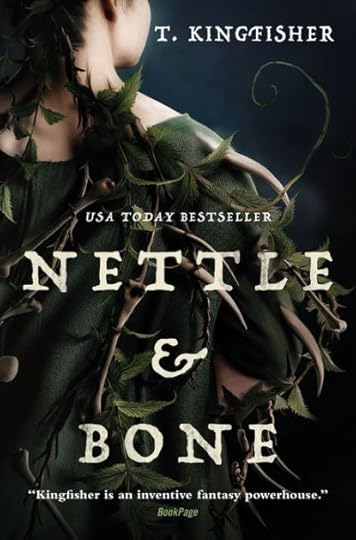
After seeing T. Kingfisher conduct author interviews at my local bookstore, I walked away with the opinion that I would get along with her and also walked away with a copy of her most famous book, Nettle & Bone. A few weeks later I read the book while out of town and was hooked from the beginning. It is short for fantasy but not for fairy tale, which is a more apt category for this dark and also kinda light tale. A cross-ages fantasy that goes down easy, Nettle & Bone is a standalone journey for a spunky princess and an acquired entourage of witch, fairy godmother, hero, and two pets, all of them twisted versions of their usual iterations. If you like that sort of thing, you should like Nettle & Bone.
Marra is the third daughter of a king, which means she’ll be allowed to just putter around and be unimportant, right? Well, the cruel prince in the kingdom next door has already worked his way through the first sister and moved on to the second, so Marra is afraid she might not be so forgotten as a pawn used for the safety of the realm. She’s relieved when she’s able to quietly retire (for now) to a convent. But when she sees more than she was intended to about her second sister’s circumstances, she can’t just sit idly by and let fate ram into her somewhere down the road—nor can she let her sister live under the whims of the cruel prince. So she asks a grave (dust) witch how Marra might free her. And the grave witch sets Marra three tasks that send her on a quest which becomes much more than just a rescue mission.
Like I said, it began with a book tour interview consisting of four authors plus the local author conducting the interview. That local author was T. Kingfisher, an author I had heard of but hadn’t given a ton of brain space to before the night arrived. (Veronica Roth was also there, and at least I had seen the Divergent movies.) My thoughts throughout the night contained a repeated impression that I would maybe get along with Veronica Roth and I definitely would get along with that T. Kingfisher lady. My ticket to the event had come with one book, but I ended up walking away with a couple more, including Kingfisher’s Nettle & Bone. I wanted to read something of hers and it was the most lauded. Weeks later I was doing some research into Kingfisher when I came across a mention of “Ursula Vernon writing under the name T. Kingfisher.” Whaaaat? This isn’t going to mean much to almost all of you, but my son is a fan of only like four books series in the whole wide world. One of them is Dragonbreath, a graphic novel series for kids by Ursula Vernon. I had met Ursula Vernon and didn’t even know it! What the heck?! Sorry, T., but I would have freaked out a little on my son’s behalf if I had known! And then shortly after that I went out of town and took along a few books to read on the plane and before bed. On the first night I picked up Nettle & Bone and snagged my new book light. I read the entire thing in just a few nights of reading and exhaustion in the quiet dark, my roommate snoozing, staying up later than I should have each time.
Even though I pretty much flew through this book, it was a little hard for me to get into at first. And even later, it wasn’t as smooth an experience as some books. I don’t exactly know why, but the writing was harder for me to sink in to. Even so, I thought the writing was more than adequate. Occasionally I was a little confused about what something looked like or how an action scene was going down, but overall, it was straightforward as a fairytale with the bonus of some fantasy world-building and a modern perspective on fairytale tropes.
Who is this book for? Something about it (size? idea?) makes one think it might be for kids. It’s not. Or that it’s YA since the character is a young woman, a princess, and we are in her head. It’s not really that, either, and by the main part of this book Marra is thirty anyhow. Combine that with themes of domestic abuse and the darkness of some of the elements (occult magic, a creepy-as-heck marionette, eternal torture, etc.) and it’s really an adult book. But the romantic vein remains fairly chaste, and Marra’s voice is a little innocent. Some have called it coming-of-age for a thirty-something. Huh. It just is what it is.
The first line of the book is: “The trees were full of crows and the woods were full of madmen. The pit was full of bones and her hands were full of wires.” We begin in the middle of the story, Marra already on the quest, finishing up the first task with bloody hands in the middle of a desert of cannibals. Yeah, some of the scenery and scenarios are pretty bleak, but as a hero Marra has to undergo some stuff. In the meantime, we get to consider the reality for female fairytale characters who were often treated as objects in the story, princesses mere pawns (or currency) in the dynamics of royal houses and impersonal kingdoms. But we’re not thinking of that so much as following Marra back into her story on its road to this moment and then on through the quest to its appropriately dynamic ending. It gets really dark, but Nettle & Bone is also shot with humor and ends up a sweet friends-made-along-the way story.
For the record, Nettle & Bone won the Hugo and was nominated for the Nebula and Locus awards. These are the top fantasy awards.
I love the last line of Anne’s review on Goodreads: “Because bibbido bobbidi boo is for punks.” It’s not totally right, but it really captures the spirit of this book.
There is something misleading about the beginning. It isn’t immediately apparent that this is a fairy tale or will have the tone of a fairy tale since the immediate structure is more modern, traditional fantasy. And while we keep the bone dog around, we don’t come back to the cannibal world or even really get into why it’s there in the first place. Cuz it’s a fairy tale and that was just a setting along the way.
A warning besides the domestic abuse: demon possession. Like, humorous demon possession, so demon possession taken lightly. I mean, there’s a comic-relief chicken possessed by a demon and I’m guessing Kingfisher has chickens and this is her retaliation mixed with love. I have one of those pets where one might be tempted to say that they are possessed or, perhaps, call him a demon dog. So I get it. But there it is. The chicken and her person are usually sited as the best characters of the book. The real moment, I think, is when we meet a woman who has a doll on her shoulder controlling her every move: this character and situation have something to say even if it is really disturbing, and the doll comes much closer to actual possession (though in this case I think we’re talking more about a non-literal possession). So humor, yeah, but still Kingfisher is tackling larger topics and occasionally scaring us. Another warning: plenty of graphic bleeding. I find this to be a book trend, strangely. Authors are big on the blood these days. I am not. Which is why I called it graphic bleeding. Probably 99.9 percent of you will not find this problematic in any book.
So a fun read that goes fast and leaves the reader with memorable characters and settings and concepts, even if the book only goes as deep as a short-novel-length fairy tale. There are issues being dealt with here, mainly domestic abuse and women empowerment, and someone who likes a dark fairy tale is going to enjoy this award-winning book.

T. Kingfisher is also Ursula Vernon! (Note: I also have two writer names to distinguish my kid stuff from adult stuff, I just haven’t published under my kid name yet.) I was impressed by her when I watched her interview other authors at a book tour and my son loves the Dragonbreath series. The author writes for both kids and adults, is a novelist and a visual artist. She has won some impressive awards like the Nebula and the Hugo. She started out doing webcomics involving anthropomorphic animals (thus Dragonbreath). Another of her more notable works is the comic Digger, though some of her short stories have also been lauded. She also does illustrations for other peoples’ work from time to time. The woman produces like a crazy amount.
And who wouldn’t want to read the award-winning A Wizard’s Guide to Defensive Baking?

“Then again, few humans were truly worth the love of a living dog” (p6).
“’Lots of people deserve to die,’ said the dust-wife finally. ‘Not everybody deserves to be a killer’” (p72).
“’But just because you need someone doesn’t mean they are under any obligation to provide. He may leave to take his chances elsewhere’” (p103).
“I do not fear retribution; I fear what sort of person I would become by doing it” (p111).
July 19, 2024
First Line: Dreadful

“He woke up with no eyebrows and no idea how he’d gotten into such a position.” –Dreadful, Caitlin Rozakis



